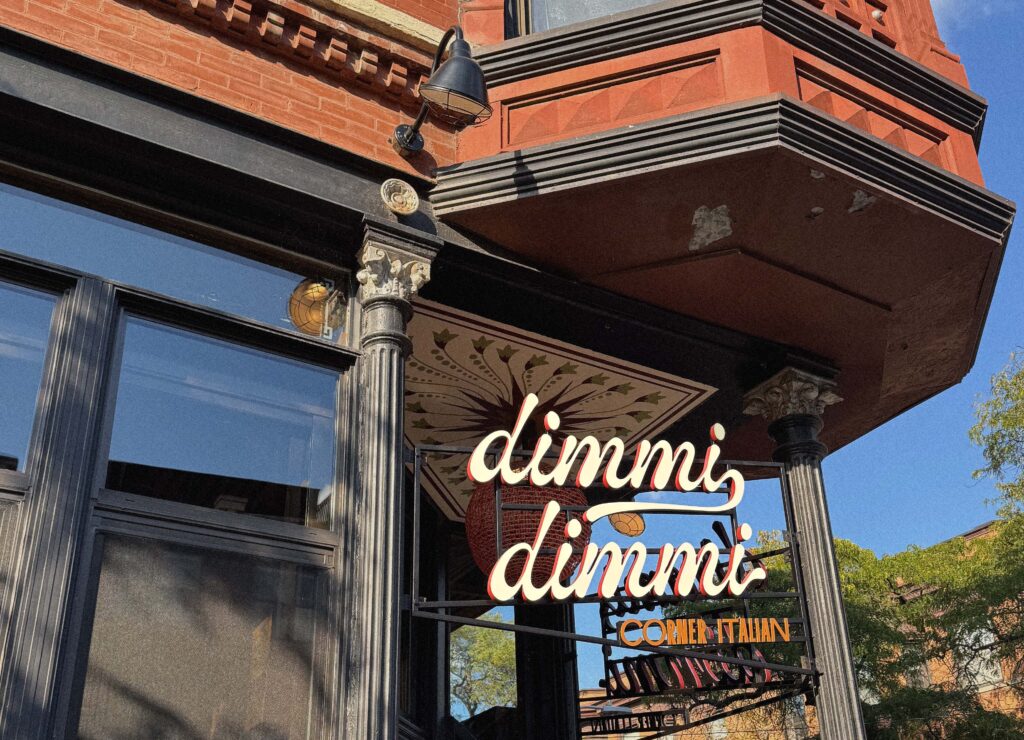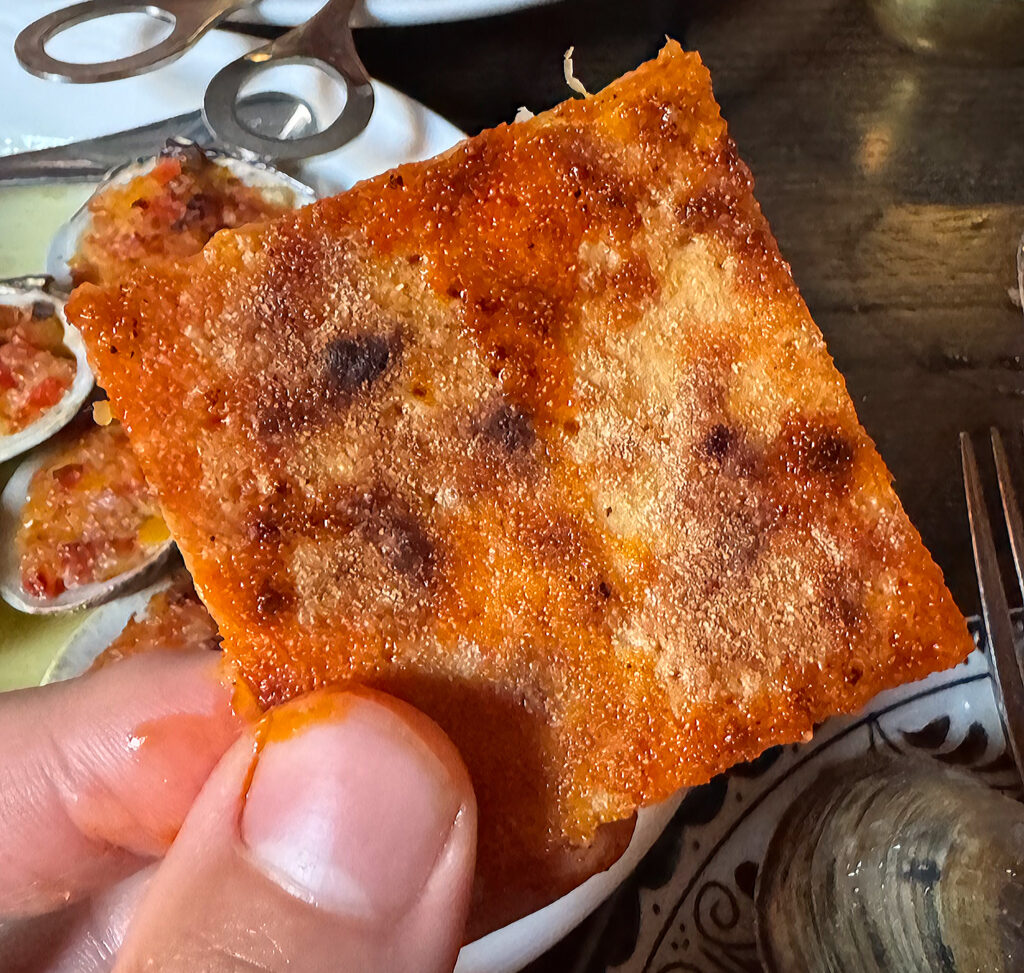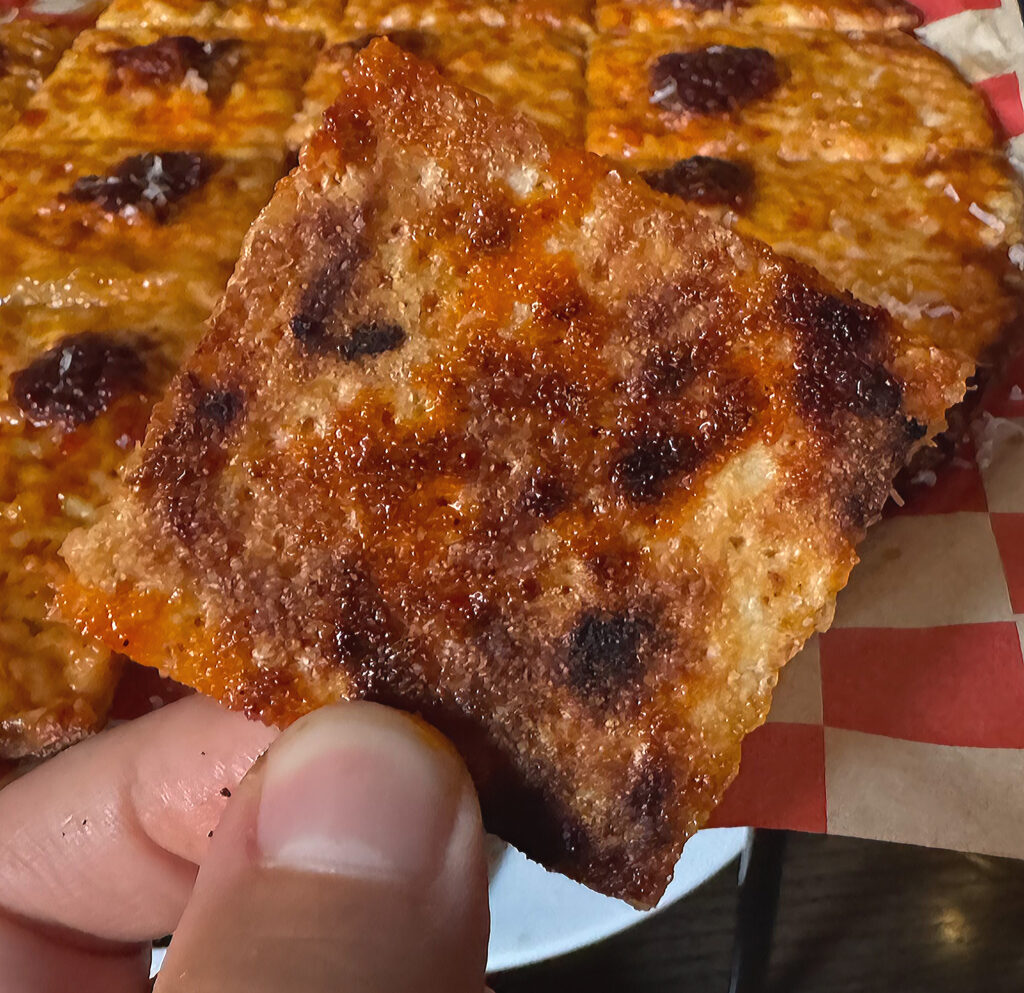Dimmi Dimmi is a neighborhood Italian-American restaurant that has quickly become one of Chicago’s hardest reservations. This may sound like a familiar story by now because it is one: taking an intimate space and applying a modern sensibility to red sauce fare of broad appeal and easy romanticization.
Elina’s and PIZZ’AMICI charmed me because they so effectively captured the charm of the old-fashioned restaurants they referenced: independent concepts, run by owner-operators (maybe even chef-proprietors), with a certain roughness around the edges (let’s call it a patina of personality), counterbalanced by a treasury of family recipes, a loyalty toward its customers, and an obvious pride about their work.
Outsiders may struggle to pierce the veil—to understand what all the fuss is about (no less when compared to the kindred places they patronize in their own neighborhood). But, once you’re in at an establishment like this, you’re in for something good. Objective quality (and it may indeed be there) gets subsumed by an emotional relationship that is infinitely more gratifying than a mere bowl of pasta.
Once one acclimates to the way things are done at this or that eatery (vagaries of seasoning and style that come down to personal taste), it becomes hard to accept any substitute. If one demonstrates the mutual respect and appreciation that this kind of hospitality entails, they’ll eat well (and feel cherished while doing so) for life.
Dimmi Dimmi rose from the ashes of one of these old-school spots: Tarantino’s, which chose to close its doors after 30 years due to “a combination of rising operational costs, city-mandated wage increases and safety concerns.” In its last weeks, the restaurant hosted “120 to 180 people…every night,” including “kids of longtime customers literally flying in just to have one last meal [t]here.” Owner John Tarantino noted, “to go out feeling like you’re on top is an incredible feeling.”
Thus, unlike Elina’s or PIZZ’AMICI (whose teams transformed unrelated spaces into dining rooms that suddenly felt like timeless Italian-American haunts), Dimmi Dimmi could tap into an actual legacy. It could build on the aesthetic, the traditions, and the community that Tarantino’s had fostered for three decades.
Why invent—however successful the illusion at those places on Grand Avenue—when you can reinvent and, in a sense, preserve what came before you? What better way to present a cuisine (no matter how a chef might wish to update it) that is so firmly rooted in nostalgia?
The picture grows more complicated when any mom-and-pop shop, even if its raison d’être remains the same, sees itself perpetuated by a larger corporate entity. The question then becomes: do the trappings of authenticity matter if the spirit with which the restaurant is run has been altered? In all fairness, could there not be benefits to a different, more expansive style of ownership if certain precepts of hospitality are still honored?
Dimmi Dimmi is decidedly not Tarantino’s “2.0.” It’s its own concept, from its own team, that acknowledges what made its predecessor so successful (even going so far as to pay Tarantino’s an homage) while forging an identity that is entirely new.
Dimmi Dimmi is also a creation of Cornerstone Restaurant Group, an entity Chicagoans may best know as the operator of Michael Jordan’s Steak House (as well as the original Michael Jordan’s Restaurant, one sixtyblue, and a series of collaborations with chef Bill Kim). Their work can also be found at Connecticut’s Mohegan Sun Resort, Grove XXIII (Jordan’s private golf club), Purdue University, and South Korea’s INSPIRE Entertainment Resort.
It’s actually Kim who put the concept in motion (and, indeed, I spotted him peeking out from the kitchen during my first visit). He matched the vacant space and the possibilities of its established genre to Matt Eckfeld: a protégé of his who cooked for 13 years at Belly Shack and Belly Q before spending another 12 with Major Food Group (including NYC’s Carbone and ZZ’s Club locations) with a stop at London’s three-Michelin-star The Ledbury along the way.
Corporate backing or not, one rarely finds chefs of this caliber coming to open restaurants in Chicago (let alone a crowd-pleasing neighborhood spot). Indeed, Dimmi Dimmi would offer Eckfeld the chance to put his “own spin on things” and “cook the kind of food” he “really love[s]” without the kind of rules he had to contend with even when working as an executive chef in the past. That would not mean “tweezer work” but, rather, “comforting,” “seasonal,” and “produce-driven” cuisine in which diners would “recognize the dishes, but they taste even better than you remember.”
In turn, Dimmi Dimmi would provide Cornerstone with the chance to channel its resources toward “supporting emerging culinary talent.” More practically, the creation of what was meant to feel “like the best version of a neighborhood Italian spot” would put the group’s name on the lips of Chicago diners who might not have known they even existed.
Since opening in August, the restaurant has certainly captured the attention of its local audience while even inspiring visits from those living further afield. If the reservation books are anything to go by, Dimmi Dimmi has been a wild success.
However, when faced with a concept of this type (especially in such a saturated genre) I tend to ask the same questions: how well does the restaurant satisfy the needs of its surrounding community and, more importantly, how well does it transcend the status of a “neighborhood spot” altogether?
It’s only by addressing the second point that one’s expectations can be properly calibrated. After all, nobody wants to plan weeks ahead and make a trek for food that’s no better (or maybe even worse) than what they can get on their own block. Yet, in some rare cases, this is exactly the trade-off through which we find an experience—so superlative—that reshapes where we feel most at home.
I will look to answer these questions using what I’ve learned from my two visits to Dimmi Dimmi (once in mid-September, again in early October), centering my observations around what I sampled the second time.
Let us begin.
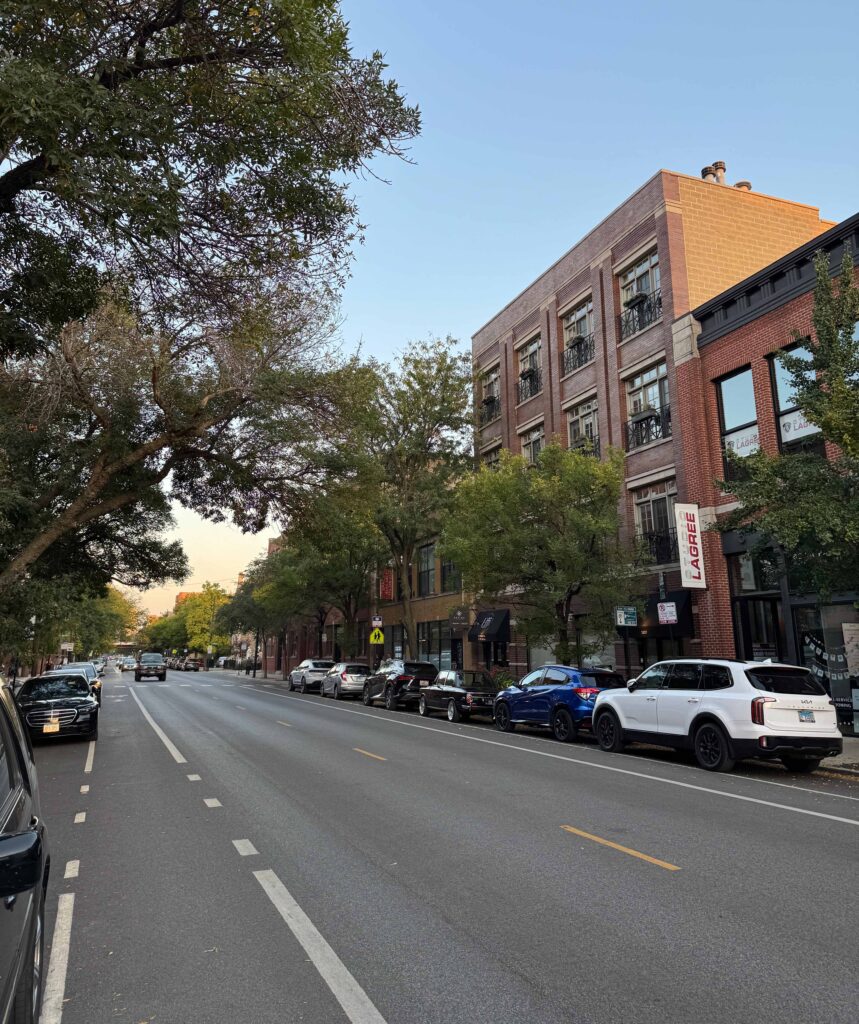
In order to fully understand Dimmi Dimmi’s appeal, one must reflect on the state of Lincoln Park dining. Admittedly, it’s a part of the city’s gastronomic tapestry I have come to think of as static: filled with time-tested concepts—filling their respective niches and catering to the immediate community—that now do little to shape how the rest of Chicago eats. Perhaps that’s the price of being so influential for so long: the barriers to entry now force the most interesting openings over to Logan Square and West Town (to say nothing of those sleepier pockets of River North and West Loop that remain).
Through concepts like Armitage Alehouse and John’s Food and Wine, the area has regained some wider relevance. S.K.Y.’s move from Pilsen (and the team’s development of associated concepts over at the Belden-Stratford) is another step in the right direction. The revival of Charlie Trotter’s, whatever form that ultimately takes, might help out too.
But Dimmi Dimmi, trading on the same type of intimacy that has fueled Hogsalt’s success just one block over, is the hot new Italian restaurant that Lincoln Park needed. Not that locals are short on options. They even had DeNucci’s (with a similar, maybe even deeper menu) open in 2023.
Whether due to the built-in base of Tarantino’s customers or its embrace of the tavern-style trend or maybe even just something to do with foot traffic (or simple scarcity of seats, or maybe the fact that the food is actually really, really good), Dimmi Dimmi achieved that breakout status. It earned a place in a longer cycle of concepts like Il Carciofo, Ciccio Mio, Daisies “2.0,” Monteverde, Rose Mary, Tortello, Tre Dita, and void (as well as the aforementioned Elina’s and PIZZ’AMICI) that have worked to redefine Italian dining in Chicago. The time was finally ripe for a Lincoln Park favorite, with the right story and backing, to have its day in the sun.
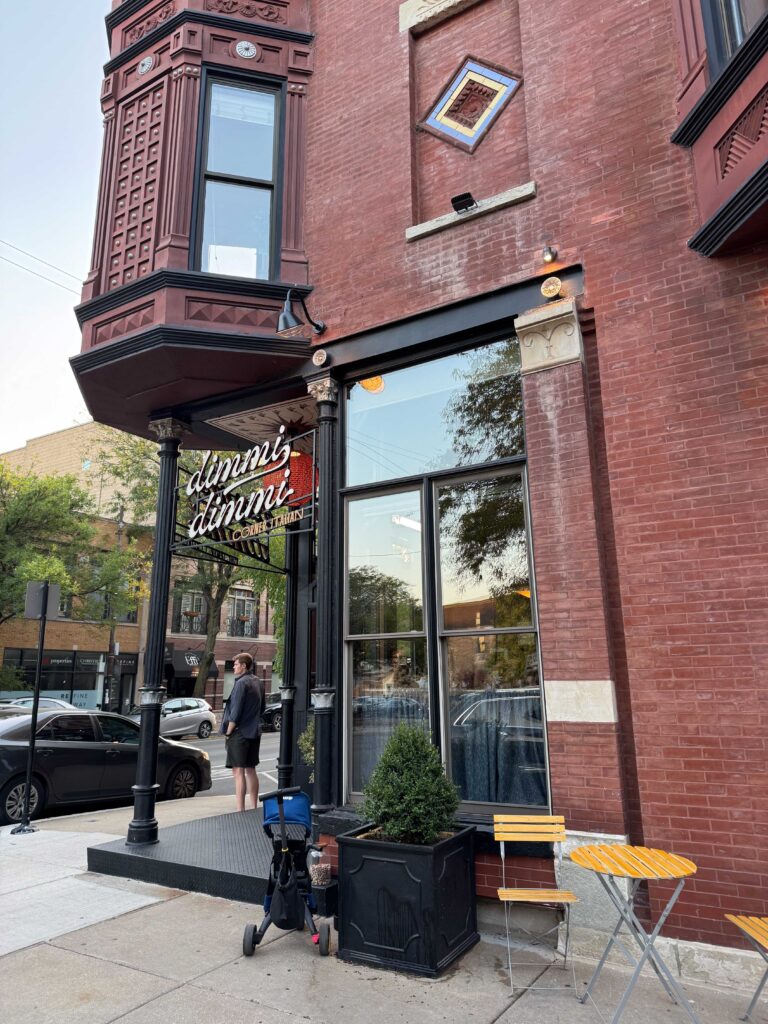
1112 W. Armitage Avenue sits far enough away from all the action (that is, where restaurants and boutiques intertwine to make an endlessly engaging walking district) to feel tucked away. The block, also home to few spas, a day care, a wine shop, and a couple cafés, is framed by residential buildings and a parking lot to the east. The same is true to the west, where the shadow of a six-story condo complex gives way to all the big-box stores found along Clybourn.
Foot traffic still flows here; it’s just coming from or going to some other, nearby destination. There’s also no shortage of prospective customers living above, behind, and around the restaurant. This is just a street (if not for Tarantino’s) they’d come to associate more with the quotidian than with the gourmet.
In this context, Dimmi Dimmi Corner Italian (as the concept’s full name goes) forms a shining addition to the neighborhood. Its black pillars and window frames—original to the space—pop against the red brick and stone accents of its overhanging building. But what could seem moody (like a mafioso’s lair) is made friendly via fanciful script (with the “i” at the end of one “dimmi” swirling toward the “i” at the start of the next one), a cute pineapple lantern, a jar of dog treats, and a set of double doors that open up to the street. The surrounding glass, which one advertised “fusilli sausage,” “corn fried oysters,” and “hearts of palm,” now provides a peek into the packed dining room. Obviously, it helps to have a crowd of prospective patrons lingering outside too.
Stepping into the restaurant, I am struck by a sense of bustle: filled seats, full plates, an energetic din (punctuated by the synchronized shaking of martinis), and the trace of self-satisfaction that comes from snagging such a difficult reservation. The Tarantino’s aesthetic, characterized by exposed brick, the patterned tin ceiling, wine bottles on the wall, and some lighter tones of wood, has clearly been reimagined—though not entirely destroyed from a structural perspective.
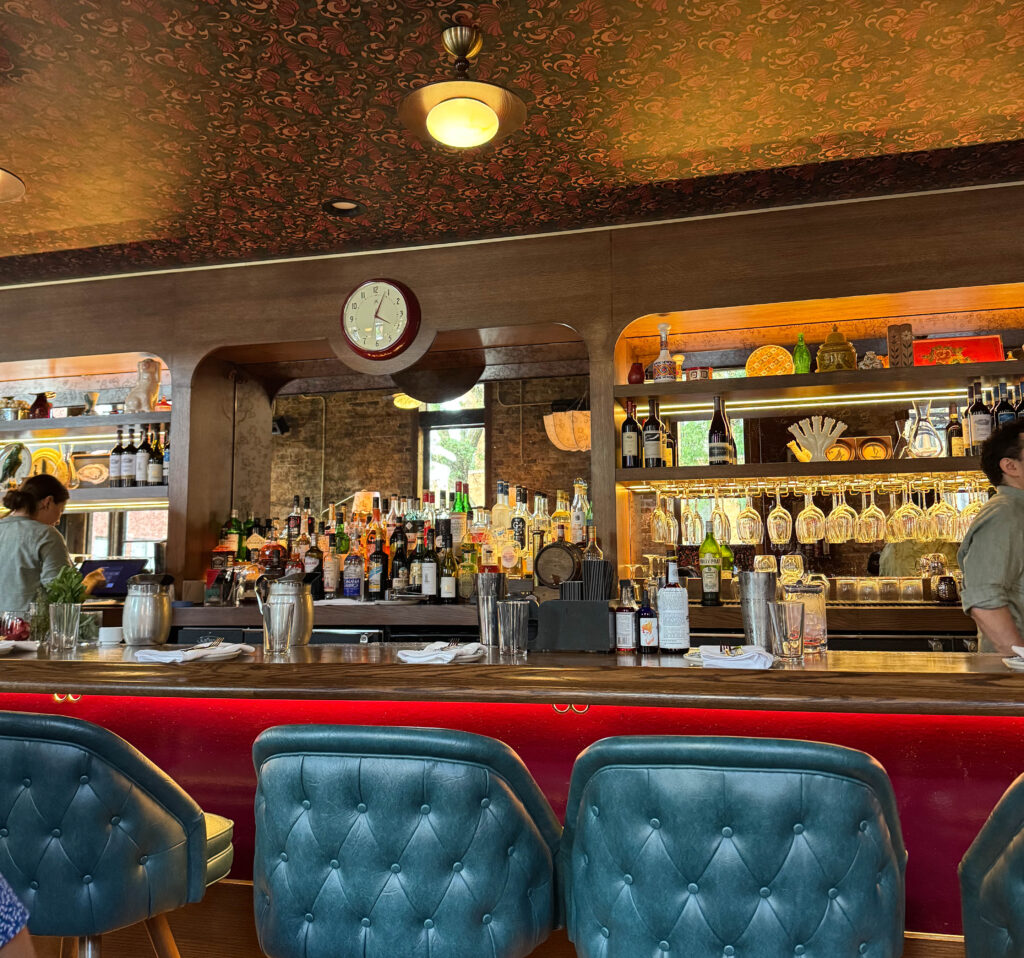
Rather, the bar has been extended so that it now forms the centerpiece of the room: with tufted leather stools, curved wood shelving, and a dropped segment of ceiling (wrapped with floral wallpaper, studded with light fixtures) serving to make these dozen walk-in spots (which, by my measure, are filled within twenty minutes of opening) feel equal to the best seats in the house. Though some patches of the former brick remain, Dimmi Dimmi has embraced a darker tone of wood and deeper reds (matched with squares of white and the occasional green leather cushion for a kind of pizzeria chic) to define the space. Metal accents, strips of floral curtain, an occasional framed canvas, and a slatted, sound-dampening ceiling (replacing that eye-catching tin) complete the effect, which is warmly cast by frilly lamps yet benefits from the airiness of ample natural light.
Seating (with capacity for 80 in total) is split between high-tops (including one that can accommodate up to eight guests), a single row of free-standing tables (for groups of two, four, or six), and cozy booths (for two, four, or five) situated around the perimeter of the room. The surfaces, tellingly, are free of the white tablecloths that distinguished Tarantino’s.
Space here has clearly been maximized, but one never feels like other parties are on top of them. Instead, the audience—a broad cross section of ages and races, clad in varying levels of dress, with a notable proportion of young children—enjoys their respective meals with the perception of privacy granted by their place among the larger crowd.
Overall, I think Dimmi Dimmi succeeds at an aesthetic level: being small (but also comfortable) and fresh (but also classic-feeling) in a way that accords with an idealized corner, neighborhood spot. It’s refined (yet not precious) in a way that’s sure to earn a second look from locals who might not have thought to patronized Tarantino’s. It’s also equipped—maybe not in terms of grandeur but baseline detail—to satisfy those used to dining in Chicago’s glitzier neighborhoods.
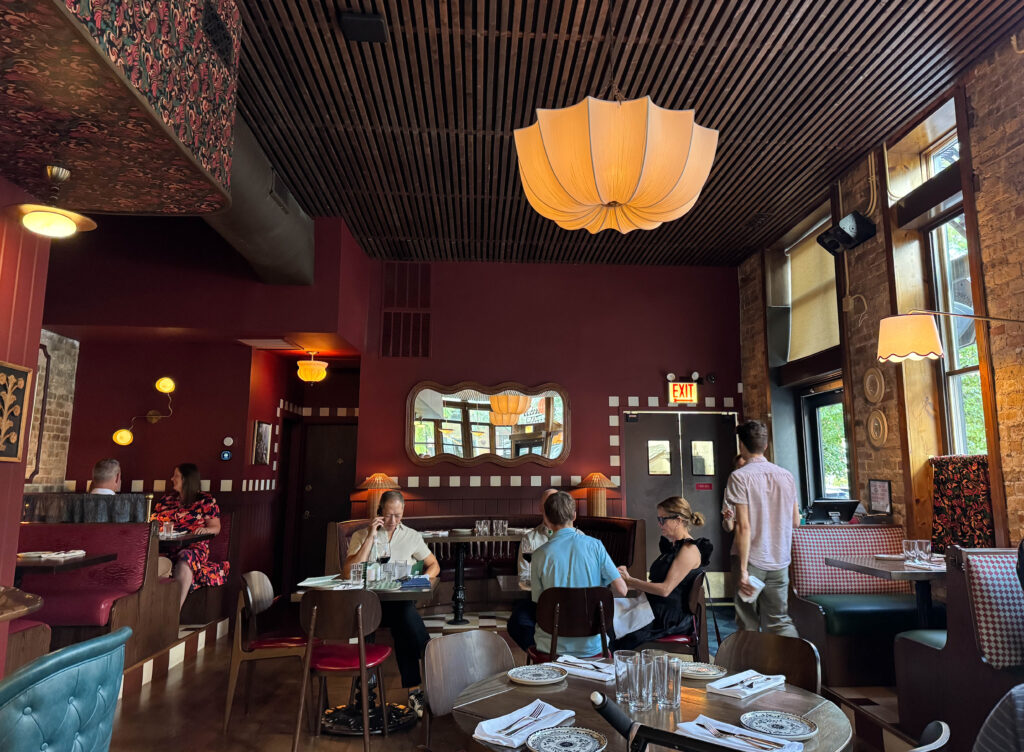
Setting, it goes without saying, means nothing if it is not equaled by the spirit of those actually working the floor. And I have to give Cornerstone (despite its somewhat uncertain gastronomic credentials) some real credit here: the service is excellent.
Mechanically, it goes without saying that the delivery and clearing of plates, the refilling of water, and the solicitation of additional drink orders proceeds without a hitch. (I’ve found that the kitchen may sometimes fire more dishes than a table can easily hold, but the front-of-house team gamely works with guests to consolidate items in a way that allows them to fit.)
What really impresses me is the way that the servers, donning their white tees and pinstriped aprons, take ownership over the dining experience. Interaction, from the first syllable, is genuinely enthusiastic: they cannot wait for you to try the food. And the rapport that is built—warm, patient, with an eye for detail—stewards the meal in an effortless manner. Specifically, I like how the menu spiel goes category to category and nearly dish to dish, describing portion sizes and highlighting favorite recipes. I also like the warnings provided when ordering spicier offerings, as well as the confidence shown when a table’s order grows to gargantuan size.
When making my second visit to the restaurant, I was struck by how immediately and sincerely I was welcomed back by my server from last time (despite not being seated in their section). It had been a few weeks, but the effect was totally convincing: this is a team that has been trained and motivated to convert first-time customers into repeat patrons and repeat patrons into regulars. However, there’s nothing uncanny about how they look to host and connect with their tables—a testament to how the dining room, despite its small size, is appropriately staffed.
Even in the worst instances, the front of house knows how to rescue a situation. Case in point, during the same second visit, a miscue left my party waiting (upon being seated) some 17 minutes to be greeted. Based on our observation, we were mistakenly put in a section whose corresponding server had not yet come out onto the floor. Whatever the cause, the reaction was striking: two clear apologies, an acknowledgement that such a wait should “never happen,” a comped order of “Sesame Focaccia” (presented with a third apology), and an unerring degree of attentiveness thereafter. From a position of justifiable annoyance, the table was successfully lulled back to a place where it could enjoy a nice evening. Personally, it was quite instructive to be subject to a wait that allowed a deeper expression of the concept’s hospitality culture to come out.
Ultimately, despite my worst fears regarding what a larger restaurant group’s involvement might entail, Dimmi Dimmi can count its human capital as a strength. The team clearly benefits from the structure and support system that ownership has put in place. Nonetheless, they display a sense of personality and heartfelt responsibility that cannot entirely be programmed. The resulting mood here is not as deliciously rough and tumble as an old-school mom-and-pop shop; however, it works with the ambiance to access the same kind of emotion and keep its customers coming back.
The beverage program at Dimmi Dimmi (and, more particularly, the cocktails) also does its part to keep guests feeling lubricated and at ease. Given how the bar and its tenders (and their synchronized shaking) form the focal point of the room, it feels fitting that their work forms one of the concept’s strong suits.

Under the “Specialty” section, a “Calabrian Dirty Martini” ($17)—made with chili vodka, a tomato-olive brine, then topped with an ‘nduja- and gorgonzola-stuffed olive—delivers a potent, appreciably salty imbibing experience with fruity depth and lasting heat on the finish. The stuffed olive, for all the fuss, comes out looking and tasting a little sad. However, I’ve sampled this drink a couple of times now and would continue to order it (though the team will also happily tailor a martini to one’s exact specifications).
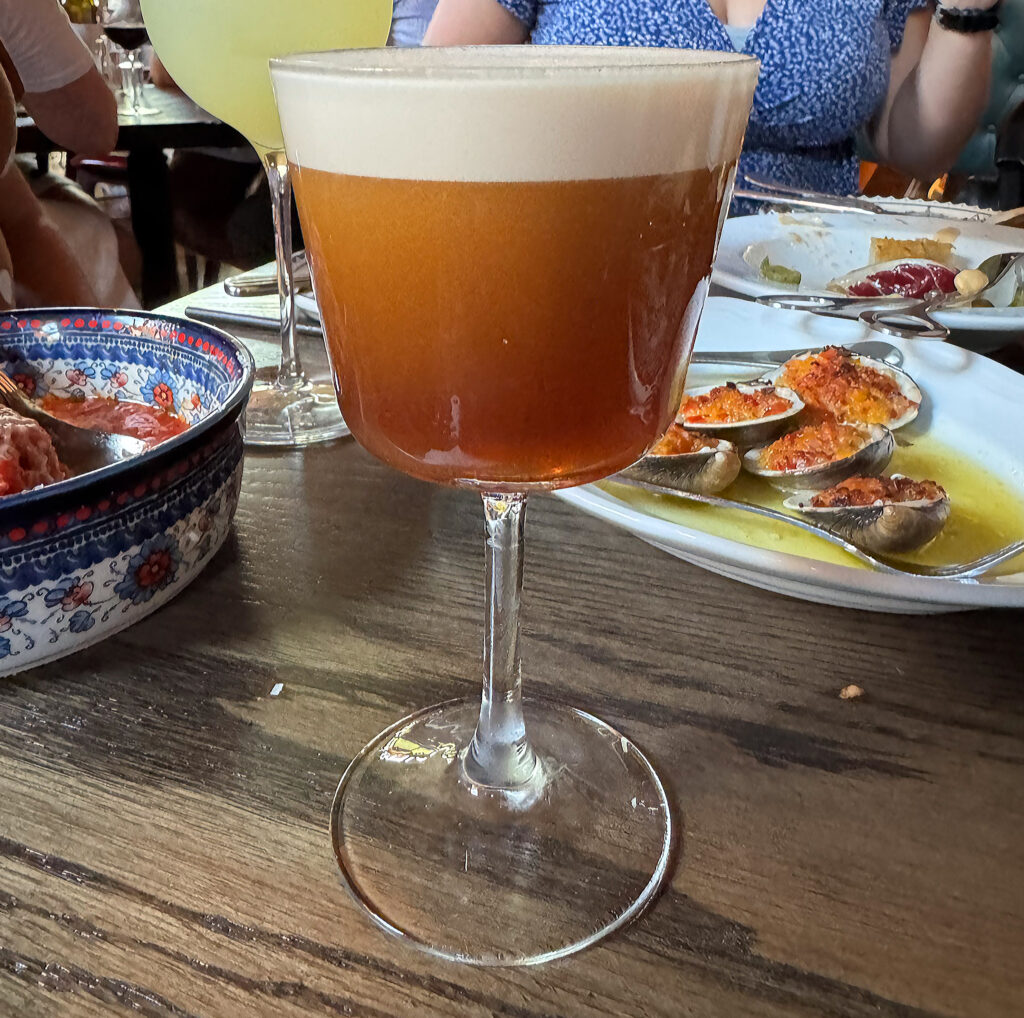
The ”Amaro Sour” ($15)—a bright, frothy, delectably bitter concoction made from Rabarbaro, Acqua di Cedro, and fresh citrus—and the “Vespa” ($15)—a surprisingly soft, floral blend of gin, Sicilian vodka, and Chazalettes white vermouth—perform even better, delivering the kind of elegance I always gravitate toward in this category. Even a “Hazelnut Espresso Martini” ($18)—flavored with four different types of liqueur (chocolate, espresso, hazelnut, and walnut)—comports itself well when compared to the countless examples of the recipe being served throughout Chicago.
Those looking for something oversized and sippable will find that anything in the “Spritz” section, comprising four styles priced from $12 to $14, forms a nice companion with the food. These are joined by a trio of spirit-free options, a half-dozen beers, and after-dinner drinks that include housemade limoncello, amari, and grappi.
The wine selection, by comparison, isn’t anything to write home about. However, it ticks the major boxes and—more importantly—does so in a friendly way.
This includes a range of by-the-glass options that spans popular grapes like Pinot Grigio ($14), Sauvignon Blanc ($14), Chardonnay ($15), Sangiovese ($12), Pinot Noir ($15), and Cabernet Sauvignon ($15) with Prosecco ($12), sparkling rosé ($12), still rosé ($14), and deeper cuts like Vermentino ($15) and Barbera d’Asti ($12) too.
Value and approachability also extend to the bottle list. Here are some representative selections:
- 2023 Jermann Pinot Grigio ($59 on the list, $24.99 at local retail)
- 2023 Bruno Giacosa Roero Arneis ($67 on the list, $37.99 at local retail)
- 2023 Duckhorn Chardonnay ($77 on the list, $33.99 at local retail)
- 2007 Lini 910 Lambrusco Rosso ($79 on the list, $32.99 at local retail)
- 2022 Résonance Pinot Noir Willamette Valley ($79 on the list, $31.99 at local retail)
- NV Ca’ del Bosco Franciacorta “Cuvée Prestige” ($89 on the list, $42.99 at local retail)
- 2019 Boroli Barolo ($98 on the list, $49.97 at local retail)
- 2020 Rocca di Frassinello Maremma Toscana ($108 on the list, $54.35 at national retail)
- 2021 Frog’s Leap Cabernet Sauvignon Estate Grown ($129 on the list, $69.99 at local retail)
- 2020 Argiano Brunello di Montalcino ($135 on the list, $89.99 at local retail)
While I cannot pretend that these choices really compel me to order wine, I certainly could if I needed to (favoring the Giacosa Arneis, Ca’ del Bosco, and Argiano Brunello depending on the style desired). Much of this has to do with the fact that, despite the chosen producers and varieties really just ticking the boxes of basic domestic/Italian offerings, the bottles are subject to such small markups.
Indeed, for the present sample, Dimmi Dimmi charges as much as 147% on top of retail and as little as 50% (with a mean of 106% and a median of 103%). This places the restaurant’s pricing among the city’s most generous examples. Certainly, the list does not offer the same intrigue as most of the places I celebrate, but I can think of many restaurants (even some old-school establishments) who stock their cellars with far less care. Yes, should a diner wish to splurge on something a little nicer than a glass of wine, they’ll find themselves treated in a neighborly fashion here.
Being pretty satisfied with my cocktails, I did not inquire about corkage during the course of my visits. However, I think a fee in the $20 or $30 range would be wholly acceptable as a means of allowing those who care most about wine to bring their own bottles. This would make it easier for oenophiles to accept what Dimmi Dimmi has chosen to offer the wider public and encourage repeat patronage from those who’d like to enjoy this cuisine with a pour of something special.
Overall, I am left feeling the beverage program offers an admirable degree of breadth with some impressive depth in a couple of its leading categories. More importantly, the restaurant presents guests with a clear sense of value: the kind that helps get a drink (whatever the kind) in everyone’s hand and set (along with what I’ve described of the ambiance and service) a celebratory mood.
I won’t deny that I’d like more from the wine list, but this is not the kind of place in the kind of neighborhood that could sustain a trendy list of natural producers. I’m not sure that collectors, at the end of the day, are really coming here looking to spend several hundred dollars on Barolo or Brunello either.
Sometimes, the only winning move is to show restraint, and I respect Dimmi Dimmi for presenting a selection that is a little bland (but otherwise approachable) rather than one that is bloated, expensive, and ultimately ill-fitted to how people are going to actually enjoy the space.
Moving to the food, which Eckfeld labels “Chicago-Italian” (as in, “not just red sauce and meatballs” but “chicken Vesuvio, Italian beef, giardiniera, and a whole sausage culture” too), I hope to see the restaurant stick the landing: to build on the foundation of hospitality it has so effectively built by delivering cuisine that balances creativity, finesse, and comfort.
Tarantino’s, for its part, centered the menu on classics like fried calamari, eggplant parmesan, chicken parmesan, pizzas, pastas, pork chops, steak, and osso buco. However, the kitchen was not afraid to buck the canon with its own recipes: like “Corn Fried Oysters” (with pico de gallo and chipotle mayo), “Mustard Crusted Salmon,” “Chicken Breast” (stuffed with goat cheese and served with apricot chutney), and “Apricot Rack of Lamb.”
Thus, it’s fair to say that Dimmi Dimmi’s built-in audience has a certain appetite for risk-taking, and the resulting menu—which spans salads, some inventive starters, pizza, pasta, and entrées—seizes the opportunity to throw a few curveballs.
Tonight, I sample 17 of the 32 dishes (including sides and dessert) on offer, looking to cast a wide net and speak to a majority of the items that an average customer might encounter. In choosing what to order, I also opt to revisit some of the recipes I found to be weakest or strongest during my first visit.
With that, the meal begins.
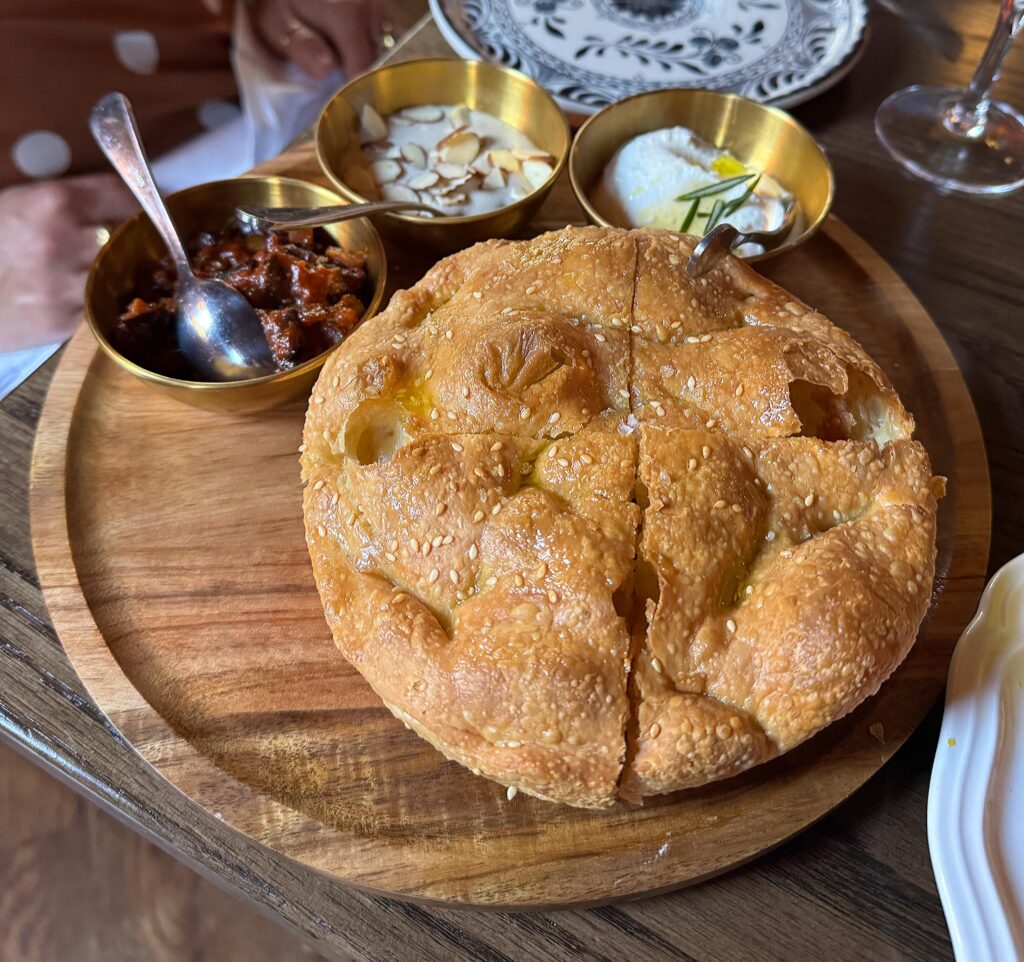
Starting at the top, a “Sesame Focaccia” ($9), laced with Sicilian olive oil, sounds like a sure thing. The crust of this bread, compared to the examples one might find the Tre Dita or PIZZ’AMICI, is of a paler brown tone and correspondingly lighter crunch. However, the crumb here is beautifully fluffy, and, when it comes to flavor, I appreciate the nutty undertones lent by the sesame. That said, this dish really distinguishes itself through its toppings: “Ricotta & Honey” ($7), “Caponata” ($6), “Creme di Fagioli” ($6), or a “Relish Tray (All Options Together)” ($16).
It’s hard not to spring for the fully monty: what amounts to a $25 bread service made up of four corner pieces and three accompanying ramekins. Of these, the “Ricotta & Honey” is the most successful (if a little conventional): driving creaminess and sweetness to the extreme with an accompanying hint of rosemary. The “Caponata,” made from fine bits of eggplant, olive, and tomato, is my second favorite. It’s not a best-in-class representation of the recipe, but it’s totally serviceable: offering moist, tender textures and its own blend of sweet and salty flavor. Lastly, there’s the “Crème di Fagioli”—a bean purée that promises the most creativity of the bunch. It comes topped with slivered almonds, and I can see how the dip (subtly earthy and sweet in its own right) looks to play off of the sesame. The idea isn’t bad, but the result feels too muted opposite the other condiments.
Overall, the “Sesame Focaccia” is hard to miss, but, by the time one tacks on those add-ons, it quickly feels overpriced compared to a wide of swath of bread services (some even still complimentary) offered at other Italian and Italian-American concepts in Chicago.
Servers will typically ensure that the focaccia arrives alongside one or more of the restaurant’s salads, which offer even further possibilities for dipping and soaking the interior.
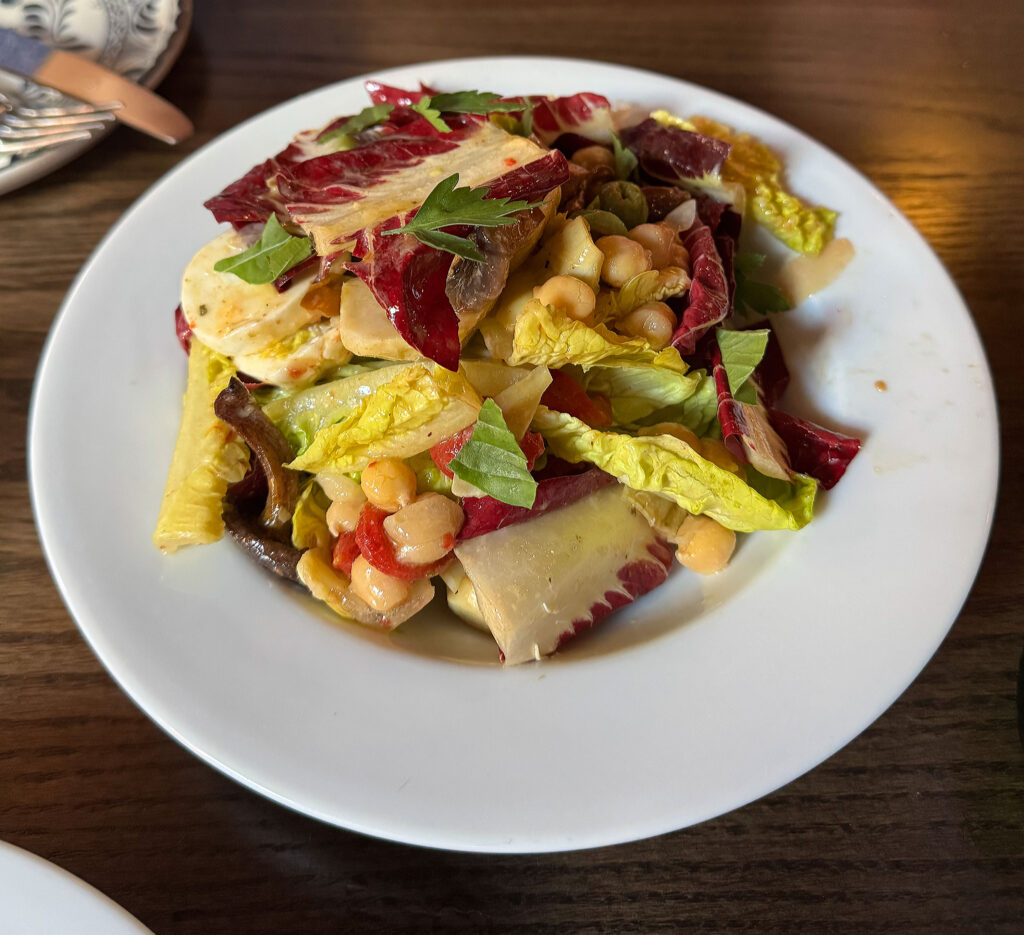
Of these, the namesake “Dimmi Salad” ($18) is the most successful, combining radicchio and gem lettuce with artichokes, chickpeas, cherry tomatoes, olives, mushrooms, and discs of mozzarella cheese. This varied blend works to build engaging layers of crunch, chew, and creaminess with each bite. Meanwhile, the house dressing does well to counteract the radicchio’s bitterness, ensuring it lands as a complicating accent rather than utterly dominating the dish. In sum, I would order this again without hesitation.
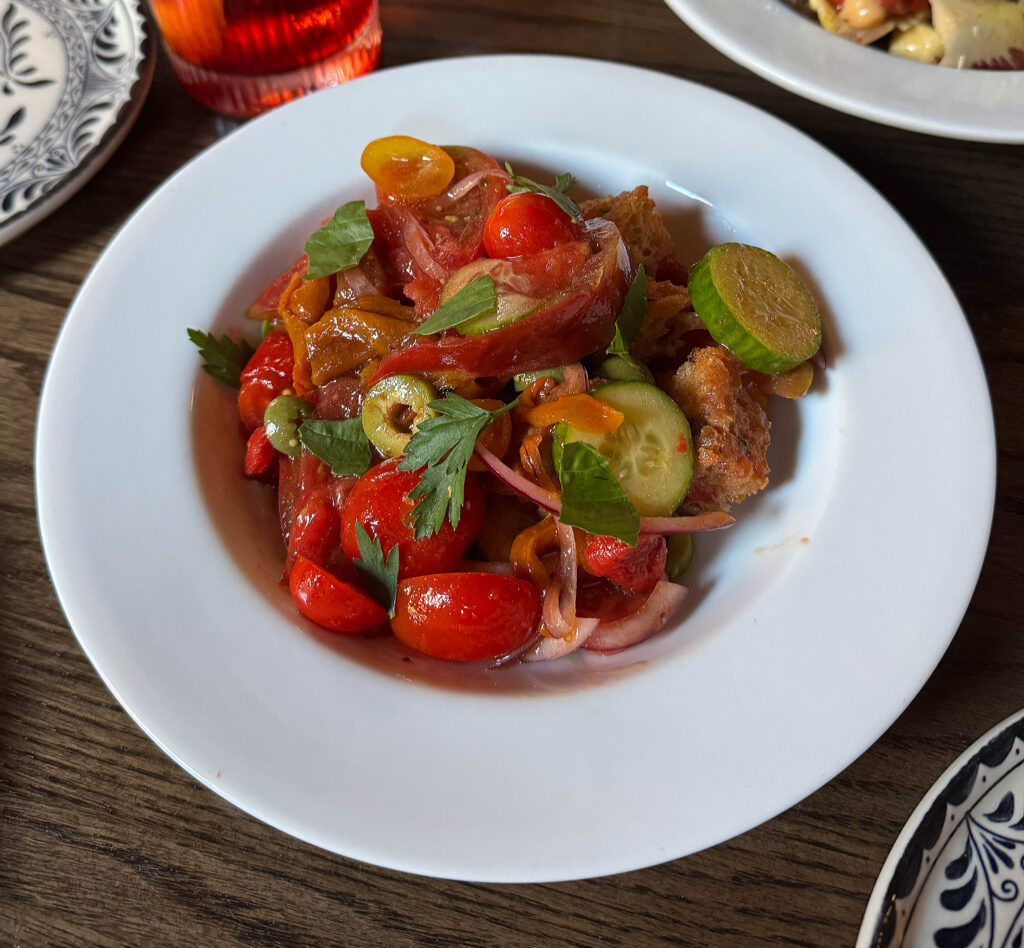
A ”Panzanella Salad” ($16), even for the most talented kitchen, is a much more difficult proposition. Here, the basic composition (made from two types of tomatoes, crisp chunks of olive bread, thick slices of cucumber, cherry peppers, red onion, olives, and a vinaigrette) is sound. However, the starring ingredient tastes only vaguely tangy and watery rather than offering any cushioning ripeness or sweetness. The dish, as a consequence, desperately needs salt, for all its crunching textures (the croutons being the most memorable component when all is said and done) ultimately veer toward blandness.
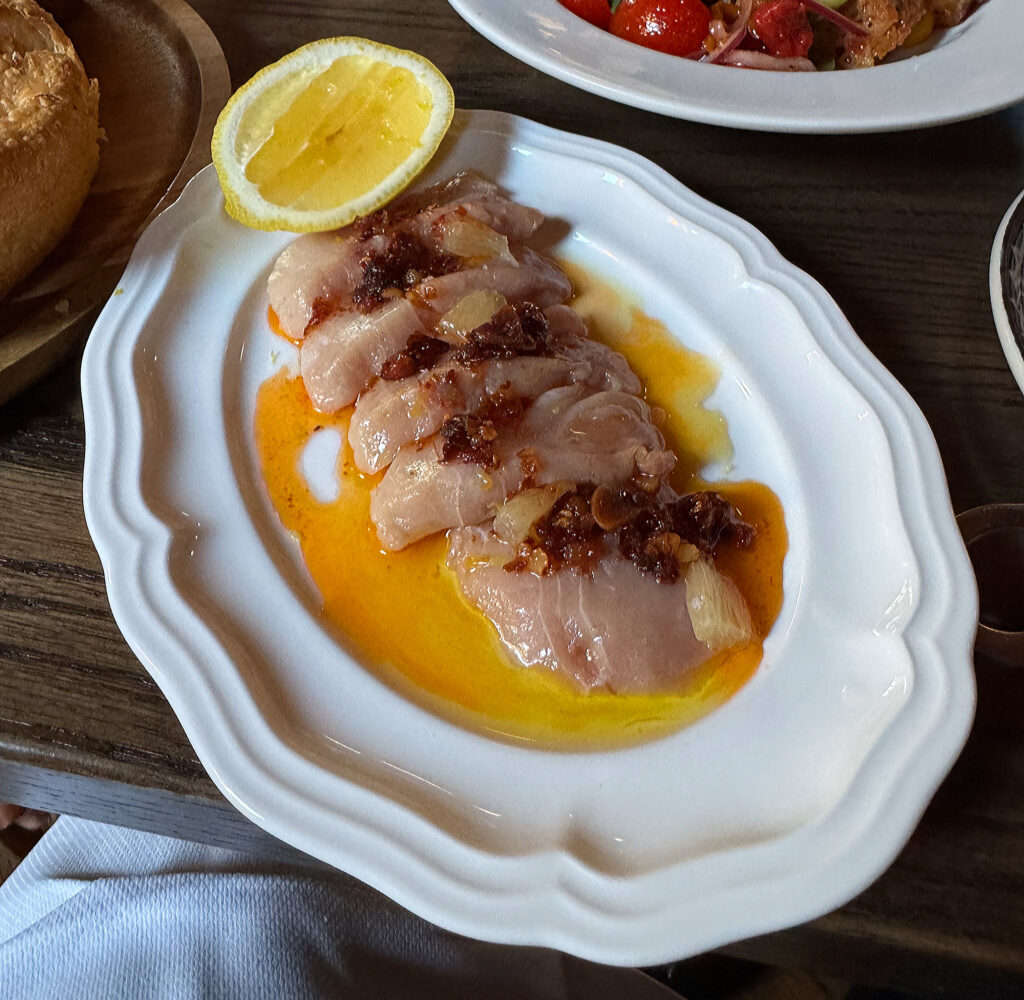
Entering the “Starters” category, I find one of Dimmi Dimmi’s more inventive preparations: a “Hamachi Crudo Diavolo” ($19) that looks to infuse the lightness and brightness of raw fish (itself more indicative of Italian-Italian dining) with the “Fra Diavolo” flavor that (applied to shrimp, lobster, or chicken) is so indicative of the Italian-American tradition.
To meld the recipes, Eckfeld dresses five thick slices of yellowtail in a red pepper-tinged olive oil and tops the quintet with an almond chili crisp. A squeeze of lemon forms the finishing touch, yielding dense (yet appropriately luscious) mouthfuls of fish that are loaded with considerable heat on the finish. The chili crisp, nonetheless, gets totally lost in the shuffle—this could be due to uneven application or an actual problem with its texture. And, while I appreciate what this recipe is going for, it ends up feeling a little clunky. For my taste, the hamachi should be cut to about half the thickness, and it would benefit from more salt and acid that, beyond adding nuance, would help to cut through the “Fra Diavolo” heat. Sharper execution of the chili crisp (especially those almond notes) would help a great deal too. This dish, in terms of depth and finesse, needs to meet the baseline of a good crudo before it looks to infuse the form with any other gimmick.
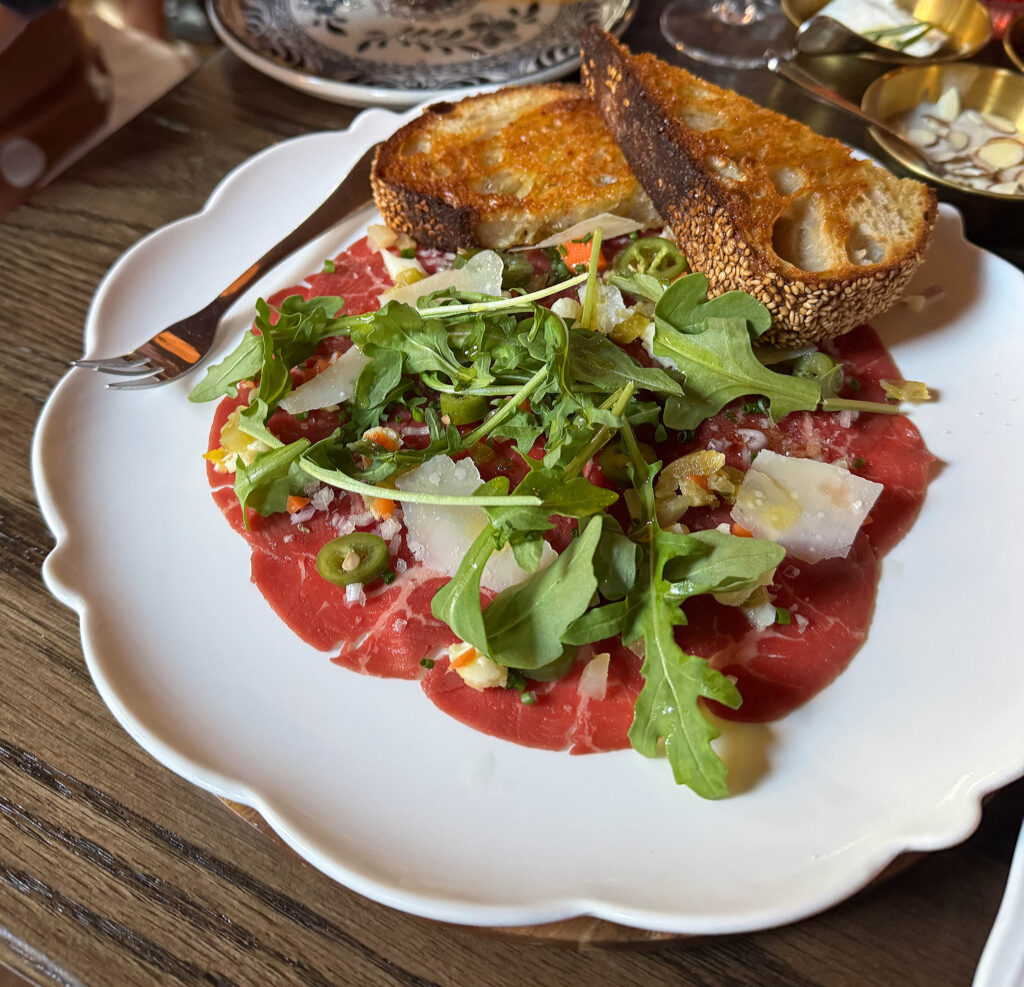
The ”’Italian Beef’ Carpaccio” ($24), offered in “hot or sweet” variations, takes the same tack: that is, it applies an Italian-American touch to a preparation that is otherwise far more indicative of how they dine in the old country. Of course, the recipe also references Chicago’s totemic sandwich quite consciously, combining gossamer slices of meat with housemade giardiniera, a beef jus aioli, arugula, shaved parmesan, and a couple slices of toasted sesame sourdough.
On the palate, the carpaccio is rendered faithfully with a thinness and tenderness that ensures clean bites. I also appreciate how finely the giardiniera (which can be quite chunky at times) is rendered, lending a tinge of heat without detracting from the essential delicacy of the beef. Atop this foundation, the arugula, parmesan, some olive oil, and a well-judged sprinkle of flaky salt drive the dish toward a fairly classic expression of flavor. Indeed, that “beef jus aioli,” which should be a headlining element, is rather hard to perceive. I don’t know how you can claim this plate actually tastes like an Italian beef otherwise. That said, when one incorporates the sesame sourdough and shuts one eye, the result comes close enough. For the same reason, I’d like to see this served with an additional slice or two of bread (ensuring there’s enough to sop up every last bite of meat). But, overall, I think the idea here is successfully executed—if anything for the way it manages to make carpaccio cool again.
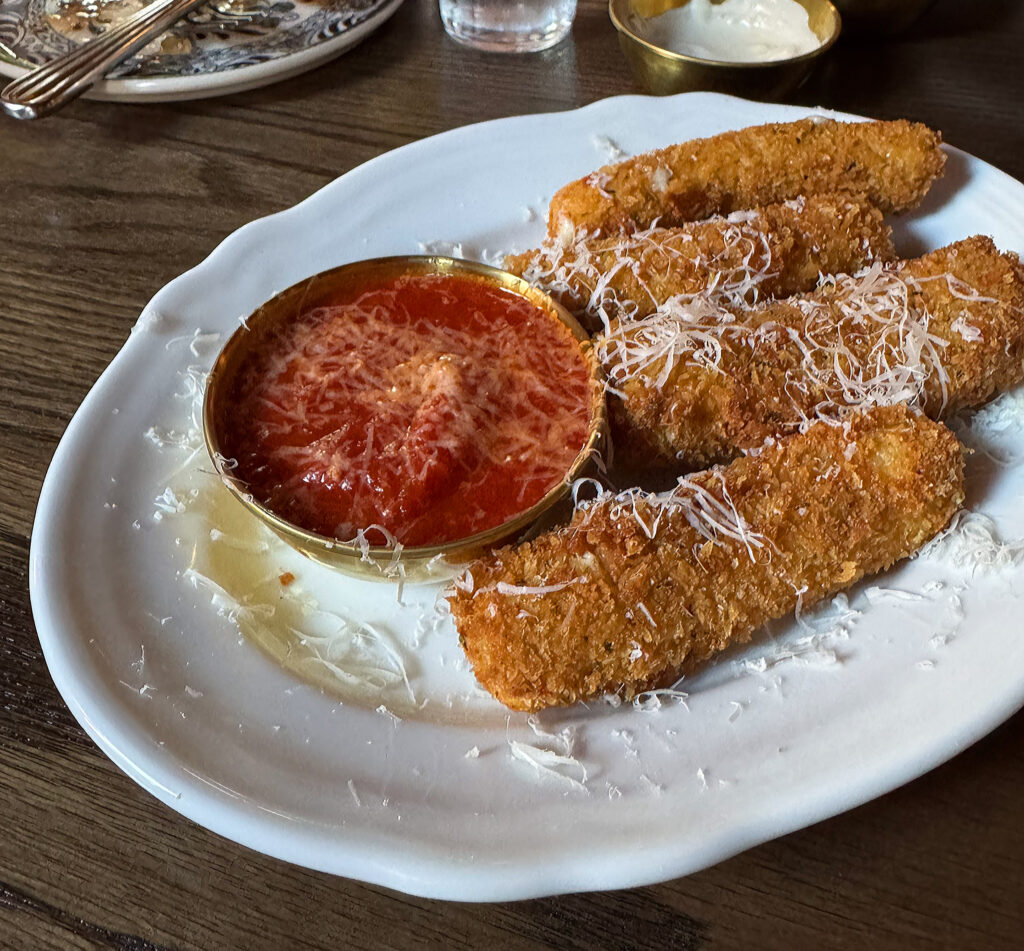
The “Hand-Pulled Mozzarella Sticks” ($15) comes highly recommended by the servers, and I cannot fault their suggestion. The dish, so emblematic of the genre’s greasy excess, is rendered here with love: housemade mozzarella, a coating of Italian breadcrumbs, a sprinkle of shredded parmesan, and an accompanying ramekin of marinara.
Texturally, the stick’s exterior displays a fine, crumbly consistency with more than enough salt (and this is a rarity) to carry each bite without further flavoring. The interior, rather than oozing, holds its shape in a manner that encourages dramatic cheese pulls. More than that, the fact that the mozzarella arrives merely warm while the marinara is served hot, is actually genius. By this method, the kitchen helps patrons sidestep the pain of scalding their tongue while presenting a more controllable temperature contrast that infuses the stick with tomatoey concentration. In sum, this is a fun, crowd-pleasing recipe handled with care—just what I’d like to see at a neighborhood restaurant of this kind.
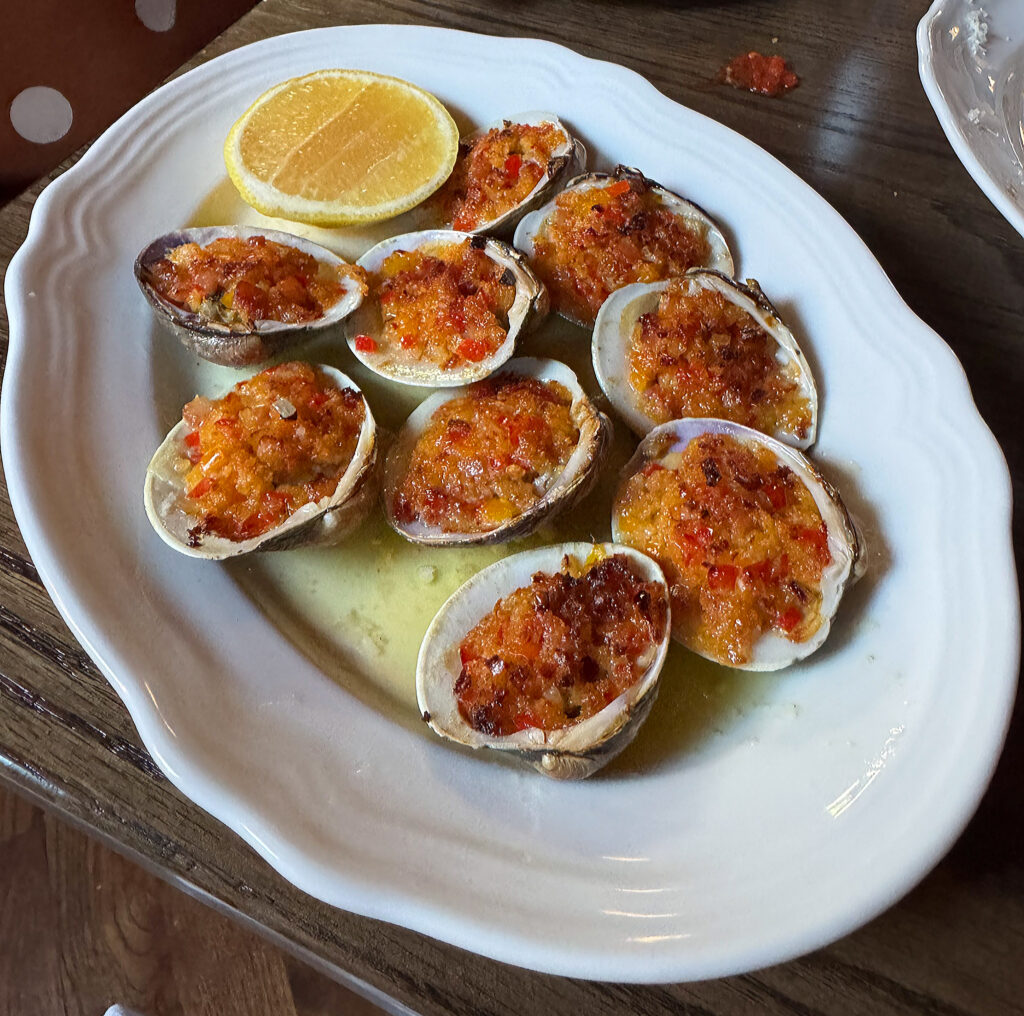
“Baked Clams Casino” ($22) references a part of that “Chicago-Italian” canon I feel has largely been lost to time. I’m not quite talking “Clams Oreganata” (technically an East Coast recipe) but something rather close: breadcrumbs, garlic, and maybe a sprinkle of parmigiano used to distinguish small, sweet bivalves. By taking “Clams Casino” (another East Coast recipe) as its inspiration, Dimmi Dimmi looks to dress its shellfish up a little more nicely.
The distinguishing factor here is bacon, and I find that the bits of crispy pork are well-integrated with the subtle chew of the starring ingredient. The resulting flavor here marries sweetness and brine with a hint of red pepper heat. But the bacon, undoubtedly, takes the lead, and it is in that capacity that this dish tastes little like the versions of “Baked Clams” that are actually native to Chicago’s Italian-American restaurants. Still, I’m not complaining. It’s nice to see a dish of this style feature at all, and I think it will reliably please those who enjoy predominant porky notes.
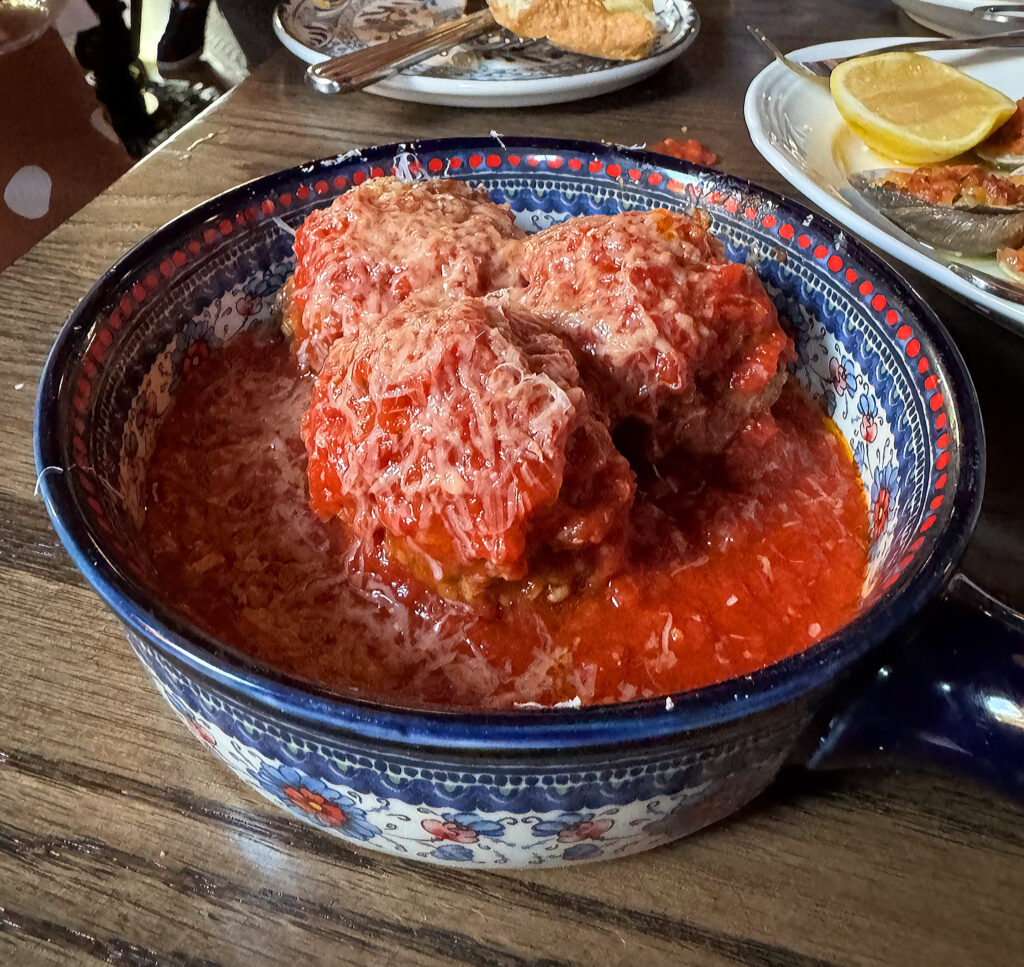
Closing out the “Starters,” a preparations “Meatballs” ($17), perhaps more than anything else in this appetizer section, begs direct comparison with other examples served around town. Given that Dimmi Dimmi’s version makes use of a housemade sausage, beef, and veal blend, I see no reason why it shouldn’t rank among the better—or best—recipes.
Visually, the three-piece serving (soaked in sauce, topped with melted parmesan) more than looks the part. However, for my palate, the grain of the meat feels a little loose rather than being entirely homogenous and smooth. The resulting flavor here, likewise, is pleasantly sweet but misses any of the deeper, more savory notes one desires from this dish. Ultimately, this is not a bad rendition by any means. It’s just forgettable, and there’s no reason a kitchen operating with such intention shouldn’t knock this item out of the park.
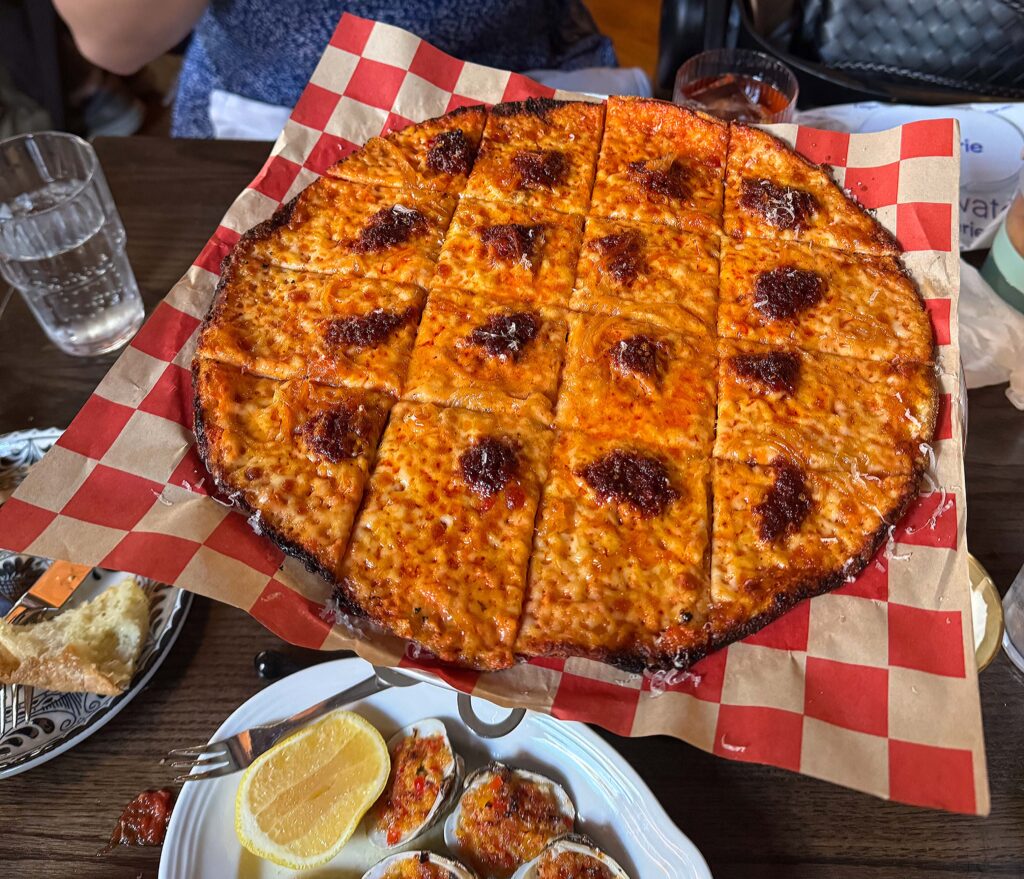
Next comes the pizza, and, as I have already mentioned, embracing the tavern-style movement that is so popular at the moment (as well as bringing some new expression of that pie to Lincoln Park) is a winning move for Dimmi Dimmi. The concept, cleverly, also centers its work on smaller four-by-four pies (free of any middle slice) that can be savored without precluding one’s enjoyment of the rest of the menu.
When I spot the “Spicy Vodka & Nduja Pizza” ($25), I get even more excited: this is a sauce, itself so totemically Italian-American, that (beyond its use with pasta) typically only appears as part of certain coalfired forms. I’ve rarely seen it make its way onto a tavern-style pie, where it can nudge the flavor profile toward increased heat and creaminess.
Visually, the resulting pizza features an even coating of cheese, a slightly orange hue, and black frill of crust limited to the very edge of the exterior slices. Toward the center of each piece, one finds a misshapen dollop of the titular ‘nduja. On the bottom, I note faint spotting, a couple traces of grease, and a dusting of cornmeal (the latter of which is always a welcome sign).
Texturally, the crust is crisp—but almost too crisp, with a tightly-knit brittleness that resists crunching apart (like a cracker) and actually needs to be chewed through rather intentionally. At a structural level, this effect is actually somewhat impressive: there’s no chance that the cheese or toppings are going to ever slide off like sludge. However, there’s something slightly off about the mouthfeel that sticks with me: not that it’s artificial, but that it’s been pushed so far to maintain a certain consistency at all costs rather than really please. The flavor here, in turn, does not smack of creamy vodka sauce or offer all that much perceptible heat. Rather, it simply offers a pleasant savory note with a tinge of allium sweetness. The sum effect is agreeable—and, given the context, easy to like—but falls far short of being memorable.

All in all, I would not skip trying this pizza whenever I find myself at the restaurant. Just the same, it is not of a caliber that I would travel for or recommend as a shining example of the form (I say this on the basis of the three pies I’ve sampled in total). It’s good—not great—and offered more as a bonus than really representing the concept’s reason for being.
By comparison, I would expect the “Pasta” category to be one of Dimmi Dimmi’s stronger suits: the stock and trade of any Italian restaurant, as well as the kind of comforting fare that a neighborhood spot should reliably nail. I am happy to report that this generally holds true.
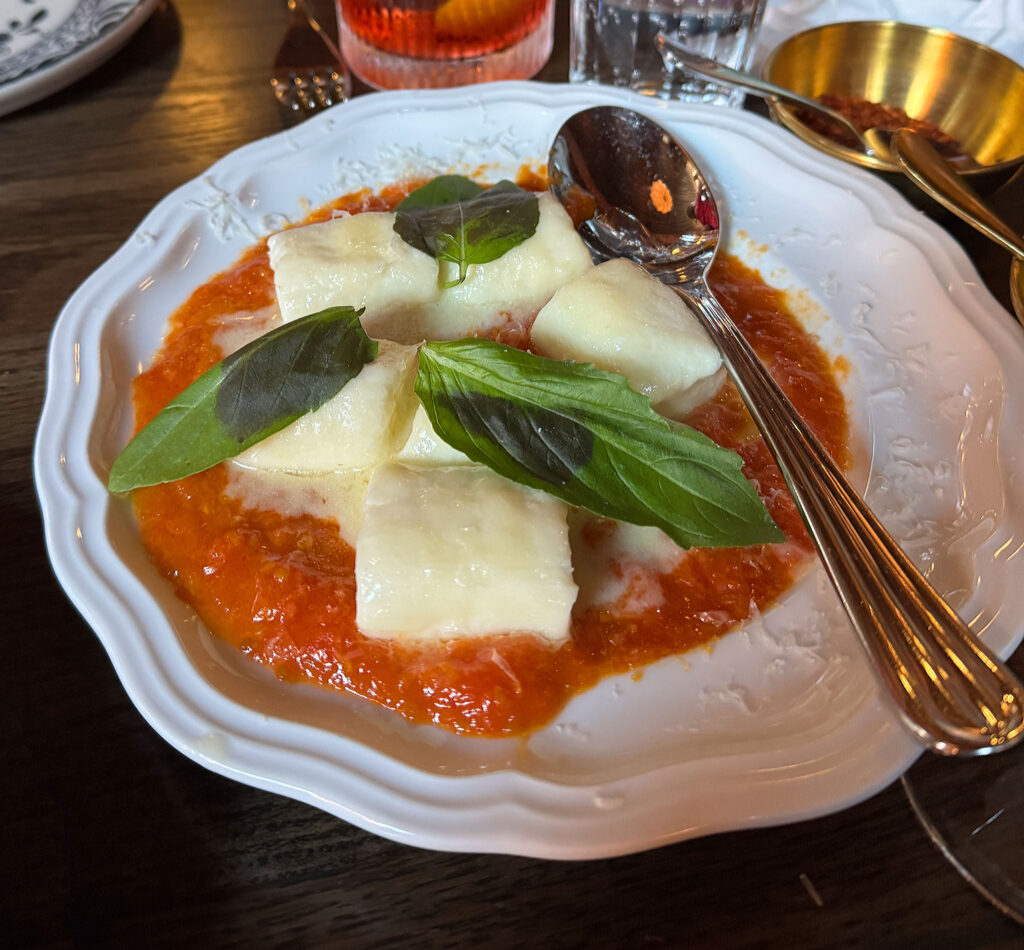
A “Gnudi Pomodoro” ($26), made from sheep’s milk ricotta and dressed simply with a sauce of fresh tomatoes, some shredded parmesan, and a few leaves of basil, starts things off. The dumplings here (five to an order) are generously sized and almost imposing. However, they prove rather pillowy—almost melty in their consistency—and are only tarnished by a touch too much salt on the finish. Still, I appreciate this firm approach to flavoring in a dish that risks being bland, and, when one factors in the tang of the sheep’s milk and the subtle sweetness of the tomatoes, this recipe more or less remains a success.
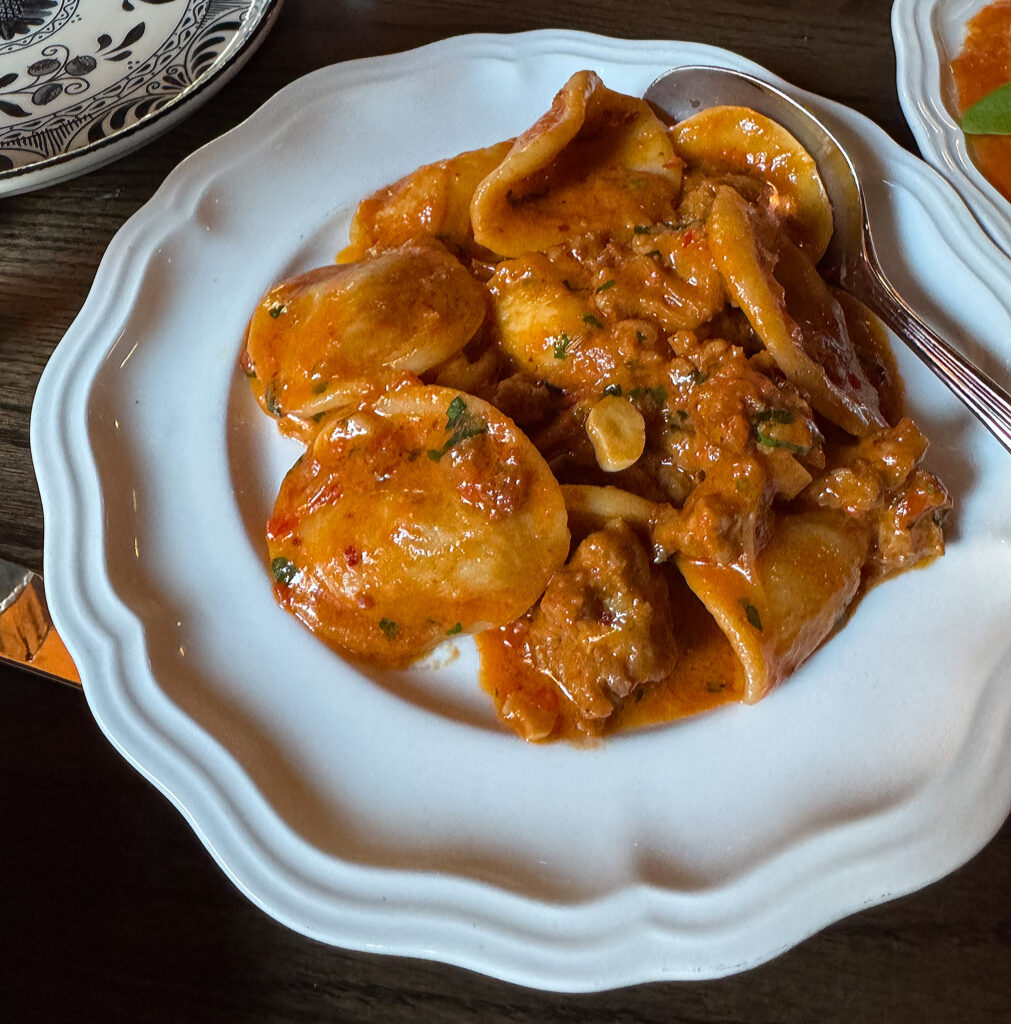
The ”Orecchiette Tarantino” ($27) is a kind homage to Dimmi Dimmi’s forerunner, and it seems to most closely resemble the “Fusilli” (with sausage and spicy tomato cream) that was once served in this space. For his take, Eckfeld pairs oversized “ears” of pasta (so large they remind me of unstuffed ravioli) with his own housemade sausage, a tomato cream sauce, and melted pecorino. The result arrives looking like a bit of a mess, and the resulting textures here—while certainly offering some milkiness—are gummy and oily at times. I also don’t really understand the juxtaposition of small, crumbly sausage chunks with such substantial bites of orecchiette (when the mouthfeel of these two elements, in any classic preparation, come closer to matching each other). Ultimately, this preparation also ends on a strong note of saltiness, making it one to forget.
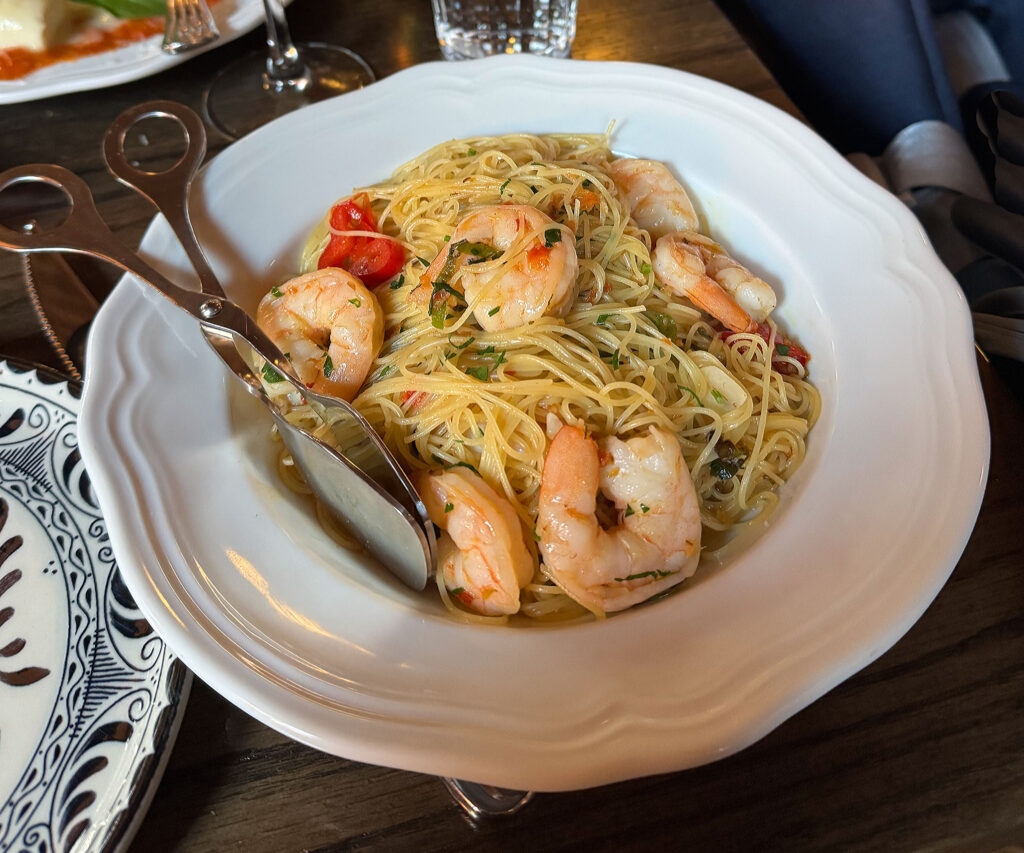
Lastly, the “Aglio e Olio Peperoncino” ($28) comes highly recommended by the servers, and, as before, they do not err in their guidance. The pasta of choice here (though not actually stated on the menu) is angel hair, and the titular blend of garlic, olive oil, and chili pepper (cherry pepper to be exact) come joined by a generous handful of shrimp. The result—soft noodles, plump shrimp, a pronounced note of garlic, and a slight sharpness on the finish—is simple yet satisfying. Better yet, I do not detect any of the same saltiness that blemished the preceding plates. While this pasta might not form the most obvious choice (compared to the archetypal red sauce), it ranks as the one dish in this category I would order again without hesitation.
Moving to the “Entrées,” I opt for a pair of preparations that I think speak most strongly to the Italian-American tradition: timeless items that, alongside the pastas, embody the comfort one seeks from their corner eatery.
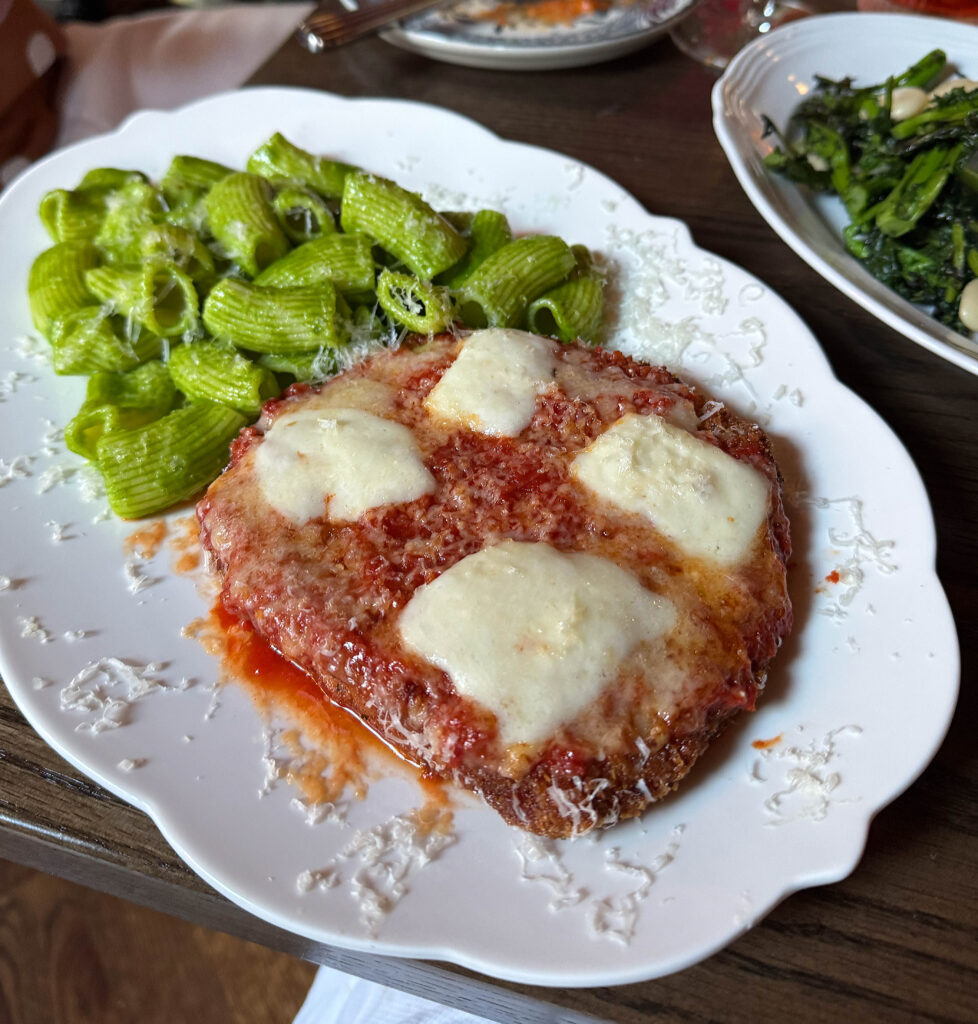
The “Chicken Parmesan” ($33) arrives neatly portioned with four distinct dabs of mozzarella studded across its surface all fused by a blanket made from shreds of the titular cheese. The cutlet only displays crispness around its edges but, otherwise, is juicy through the interior and well-matched by the melty consistency of its toppings. The accompanying sauce, similar to what I tasted in the “Gnudi Pomodoro,” delivers ample acidity with enough corresponding sweetness to yield pleasure. I like the fact that the rigatoni pesto served on the side is unique to this dish, yet it’s also a tad gummy and bland. Overall, this makes for a good—not great—example of the form, and, considering the nostalgic nature of this recipe, it’s certainly equipped to please most diners in this particular context.
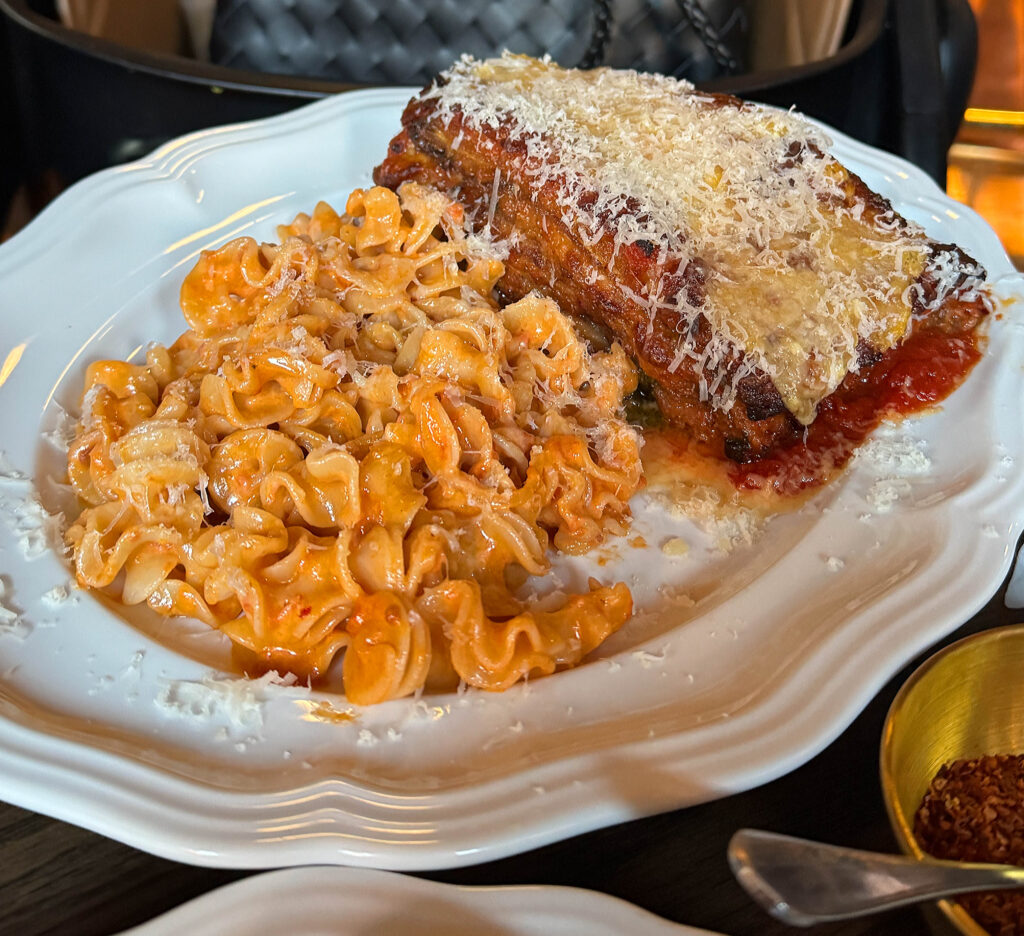
In my opinion, it’s much harder to do “Eggplant Parmesan” ($26) justice, and Dimmi Dimmi shows why. The nightshade—composed of thin, sauced layers and crowned with a kindred topping of melted mozzarella and parm—boasts a faintly crunchy top. However, it is dense and fairly undistinguished through the middle and oily on the bottom. The resulting flavor here, likewise, is vaguely savory with a bit of supporting sweetness from the tomato. Ultimately, I’ve encountered much worse examples of the form before, and this one is certainly serviceable. There’s just not much going on with it, so it reads more as a vegetarian option than a specialty in its own right. Thankfully, an accompanying serving of fusilli vodka is actually rather good (tasting like a kind of spicy mac and cheese). It ranks favorably compared to the pasta dishes I described earlier and helps to boost one’s perception of the headlining eggplant.
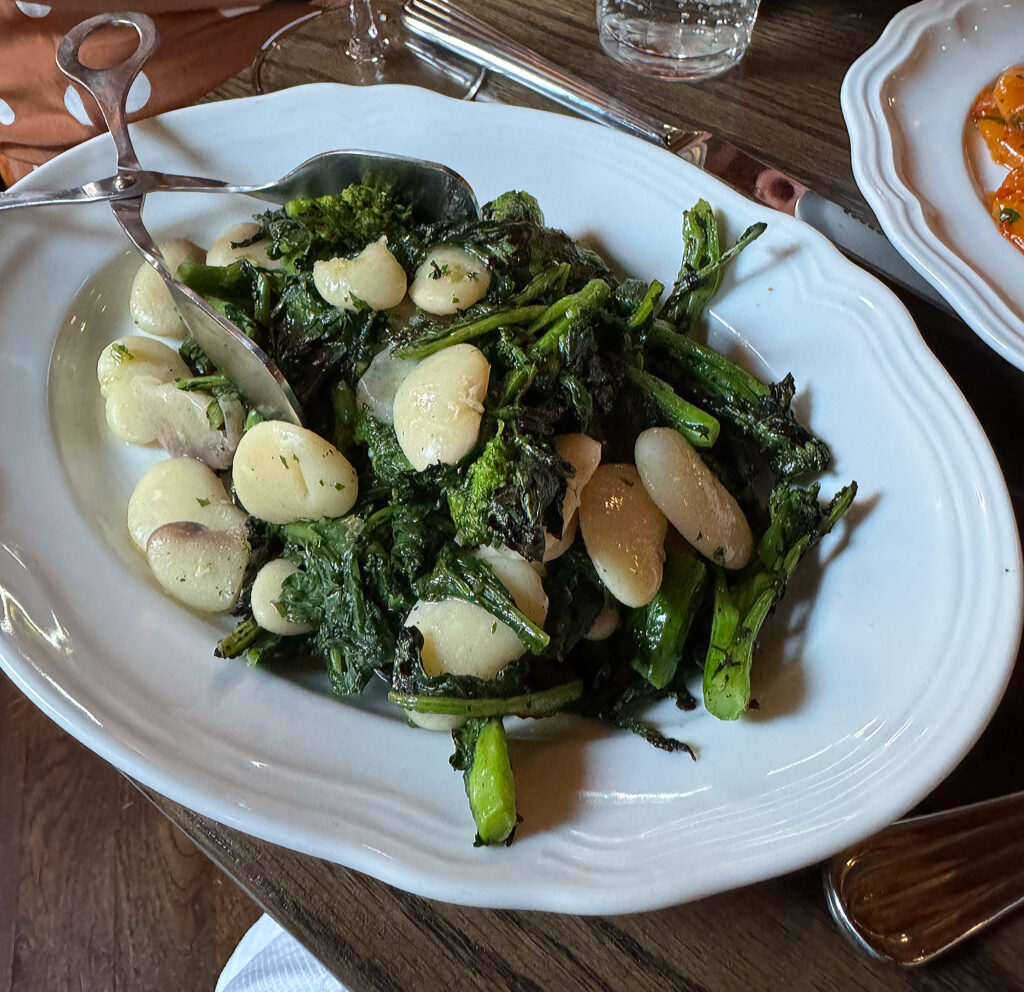
Of the three “Sides” offered on the menu, the “Broccoli Rabe & Fagioli” ($8) catches my eye. It’s another recipe that can be quite hard to master—being that managing the texture (somewhere between crunchy and stewed) and the bitterness presents a double challenge. Though Dimmi Dimmi is wise to pair the rapini with gigante beans, they prove chalky. The broccoli rabe itself is on the firmer side (no unpleasantly so) but also feels overly charred. Indeed, I only taste bitterness here, finding none of the sharp garlic, nuttiness, or sweetness that actually makes this ingredient appealing. In sum, this makes for the weakest item of the night.
Closing out the meal, the two “Desserts” I order—so classically and decadently conceived—seem capable of ending my night on a positive note. They more or less do so.
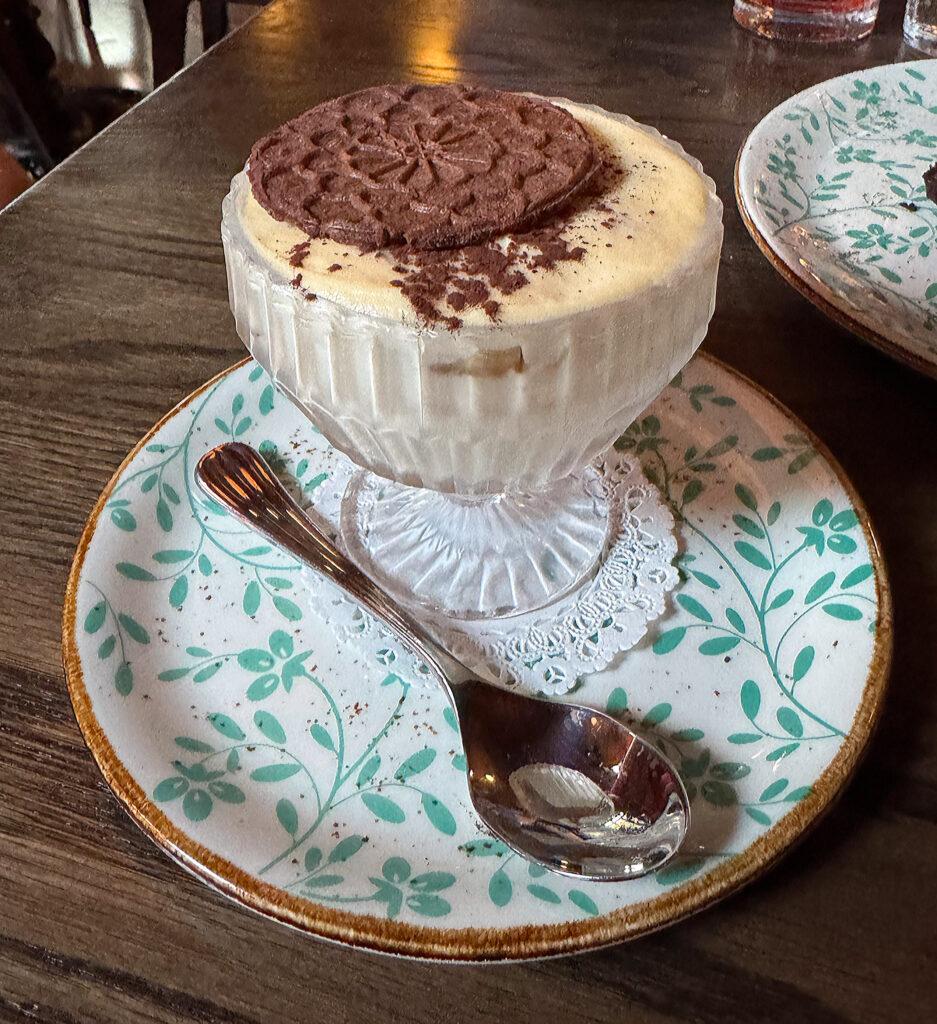
A “Tiramisu” ($14), served in a sundae bowl, combines the familiar espresso-soaked ladyfingers, mascarpone cream, and cocoa powder with a crowning wafer cookie. It’s a welcome touch, but the dish’s texture is thicker and richer than what I prefer. Yes, it eats more like a pudding than an elegant, whipped assemblage. However, the resulting flavor—so perfectly bittersweet—rings true. Overall, this makes for a good (if decadent) example of the form.

The ”Chocolate Cake ($16), by comparison, looks to embrace decadence wholeheartedly: blending a buttermilk crumb with a mousse filling, a thick frosting, and a counterbalancing scoop of vanilla gelato. The result delivers all the concentrated, milky tones one desires from this kind of dessert. However, the cake itself lacks any of the fluffiness or moistness that would actually help to distinguish and enhance its richer elements. Indeed, the dish eats like a dense slab of chocolate, and it’s only with the addition of the gelato that some of its depth of flavor comes out. Ultimately, this item may be tough for some guests to finish, but it also undeniably scratches its target itch.
When all is said and done, I’ve sampled some 17 dishes in a matter of 75 minutes (counting the time from the arrival of the first plate to the arrival of the last). No doubt, this is a breakneck pace—one that might have been intended to make up for the delayed greeting I mentioned earlier. However, some of the flights of food (as I also noted) pushed the limits of what the table could comfortably hold, and the overlapping of those flights (hot appetizers coming before all the cold ones have been finished, pizza coming while hot appetizers are still there to be eaten) wasn’t always ideal.
Still, I think it’s acceptable for a restaurant of this style to feed its community as efficiently and reliably as possible. It actually pained me to see the four-top next to me linger over cocktails for an hour and leave without ordering any food. And, to be honest, the only thing I might complain about is the fact that my three pastas were served at the same time as two entrées that each had their own sides of pasta (an onslaught of items that, in all fairness, was managed with surprising ease since several of the recipes were not worth finishing).
That said, there’s no hard feelings. And, when the check arrives without any “service charge” nonsense, Dimmi Dimmi’s neighborly approach to dining fully cements itself.
From there, it’s a short walk back onto Armitage, where another round of neighbors eagerly awaits its chance to step inside and feel at home.
In ranking the evening’s dishes:
I would place the “Dimmi Salad,” ”’Italian Beef’ Carpaccio,” “Hand-Pulled Mozzarella Sticks,” “Gnudi Pomodoro,” and “Aglio e Olio Peperoncino” in the highest category: very good recipes I would be happy to sample again (but that just failed to elicit an extra degree of emotion).
Next come the “Sesame Focaccia,” “Baked Clams Casino,” “Hamachi Crudo Diavolo,” “Meatballs,” “Spicy Vodka & Nduja Pizza,” “Chicken Parmesan,” “Eggplant Parmesan,” “Tiramisu,” and “Chocolate Cake”—merely good (maybe just average) items that fell short when it came to texture or flavor. None of these bites faltered in more than one dimension, so there was still pleasure to be had (and, indeed, they could all easily be fixed with a little more tweaking).
Finally, we have the ”Panzanella Salad,” ”Orecchiette Tarantino,” and “Broccoli Rabe & Fagioli”—three underwhelming dishes that were clearly flawed across multiple dimensions and that I would not order again barring clear changes.
Overall, this makes for a hit-rate of 29% to 82% depending on how harshly one chooses to judge the “merely good” preparations that land in the middle category. On some level, I do believe that wanting to order something a second time is the real definitive test of quality. If I found myself at Dimmi Dimmi once more, I must admit that I would most certainly order the “Sesame Focaccia,” “Baked Clams Casino,” some sort of “Pizza,” and probably the “Tiramisu” again.
So, should I say the hit-rate is actually 53%? Or is it maybe worth framing things a different way?
For those who live in Dimmi Dimmi’s neck of the wood—who appreciate an intimate (yet still family-friendly) environment, who prize connecting with servers, who will find that favorite cocktail and sip it until the end—the hit-rate is 82%. That is to say, barring a couple clear missteps, you can have a nice, comforting meal that delivers all the classic dishes with a good baseline quality and some fashionable, trendy touches to boot.
For those who live elsewhere—who favor their own local Italian-American spots or already frequent those establishments (in glitzier areas) considered to be modern masters of the form—the hit-rate is 29%. Save for a couple clever “Chicago” spins, nothing you eat here is going to command your attention (let alone rank among the city’s best examples). The wine list isn’t going to impress you either, and, while warm service and well-crafted cocktails are fine and dandy, they do not move the needle when one is motivated to find the finest food possible.
In short, my experiences have left me feeling that Dimmi Dimmi is doing great work as a “neighborhood spot,” but it in no way transcends that status. Indeed, I think the second someone needs to plan a reservation more than a month in advance or travel any distance to try their luck walking in, the returns granted by this restaurant diminish precariously.
(Certainly, one can apply this argument—rooted in convenience—to a small place like PIZZ’AMICI too. But the pies there, even if one rejects their status as “the best,” hit a high enough quality that at least partially justifies the pain. I feel the same way about the eggplant at Elina’s. Dimmi Dimmi has no such killer item on its menu.)
Really, this is not an indictment of what Cornerstone is trying to accomplish, for no restaurant in Chicago is executing Italian-American food at a Carbone (let alone a Torrisi) level of quality. And nobody even really seems capable of conjuring the right aesthetic or approach to service or essential romanticism that revitalizing this genre entails.
The groups that have the resources to do so don’t possess the requisite love for the cuisine, and the independent concepts that come closest, which do have the passion, lack the largesse required to build a true destination.
Dimmi Dimmi seems caught in the middle: capable of putting together some of the trappings necessary and tying them together with the precision that corporate backing entails. However, they do not go all the way—toward glamour, luxury, and exclusivity of the highest degree (none of which exist for their own sake but as a multiplier of what’s actually being done on the floor and in the kitchen). Nor do they operate with the level of ownership and close attention toward the food that allow even smaller restaurants to nail each and every plate.
Ultimately, is there really even any need to pursue excellence when this cuisine, in its myriad forms, remains such an easy sell? As with steakhouses, there are plenty of Italian restaurants in this city that I (so confident in my own preferences) will never deign to step foot in. There are many more I haven’t heard of and never will.
All the same, by appealing to natural variations in taste, budget, and geography, these establishments each find their respective ways of meaningfully pleasing the dining population. An obsession with “the best” (whether it comes from well-heeled gastronomes or American culture more broadly) should not obscure that fact. And it is to Italian-American food’s massive credit (as a product of poverty and subsequent abundance) that it can reliably satisfy even when represented in a less-than-perfect fashion.
In the final analysis, I continue to admire Elina’s and PIZZ’AMICI because they are small and specialized. In turn, I enjoy Ciccio Mio, RPM Italian, and even Tre Dita (despite its flaws) when I want the spectacle and depth of offerings—especially when it comes to wine—that larger operators can deliver. Places like Il Carciofo, Monteverde, and Rose Mary, meanwhile, help fill in the gaps (depending on what particular sort of inflection I may be seeking).
Yet Dimmi Dimmi, this is to say, does not crack the lineup. Barring a sizable upswing in execution across the board, I don’t ever see it changing my established dining habits. Nic + Junior’s certainly didn’t, and that concept had the benefit of occupying a singular subgenre within the wider tapestry of Italian restaurants.
But I appreciate what these chefs are all trying to do for their communities, and the corresponding hospitality cultures they have built make these places easy to root for. Chicago—and the state of Italian dining here—would be better if each neighborhood and each block benefitted from the same fresh perspective and respect for those who came before.
At the same time, these are not necessarily places or stories that anyone outside those boundaries need get excited about. That is what makes them, on one hand, so personal and, on the other, so widespread as to form a trope: the restaurant on the corner whose actual quality starts and ends there.

